- Chess (Gr. 1-4)
- TV (Gr. 1-4)
- Metal Detectors (Gr. 2-6)
- Tetris (Gr. 2-6)
- Seat Belts (Gr. 2-6)
- The Coliseum (Gr. 2-6)
- The Pony Express (Gr. 2-6)
- Wintertime (Gr. 2-6)
- Reading (Gr. 3-7)
- Black Friday (Gr. 3-7)
- Hummingbirds (Gr. 3-7)
- Worst Game Ever? (Gr. 4-8)
- Carnivorous Plants (Gr. 4-8)
- Google (Gr. 4-8)
- Honey Badgers (Gr. 4-8)
- Hyperinflation (Gr. 4-8)
- Koko (Gr. 4-8)
- Mongooses (Gr. 5-9)
- Trampolines (Gr. 5-9)
- Garbage (Gr. 5-9)
- Maginot Line (Gr. 5-9)
- Asian Carp (Gr. 5-9)
- Tale of Two Countries (Gr. 6-10)
- Kevlar (Gr. 7-10)
- Tigers (Gr. 7-11)
- Statue of Liberty (Gr. 8-10)
- Submarines (Gr. 8-12)
- Castles (Gr. 9-13)
- Gutenberg (Gr. 9-13)
- Author's Purpose Practice 1
- Author's Purpose Practice 2
- Author's Purpose Practice 3
- Fact and Opinion Practice 1
- Fact and Opinion Practice 2
- Fact and Opinion Practice 3
- Idioms Practice Test 1
- Idioms Practice Test 2
- Figurative Language Practice 1
- Figurative Language Practice 2
- Figurative Language Practice 3
- Figurative Language Practice 4
- Figurative Language Practice 5
- Figurative Language Practice 6
- Figurative Language Practice 7
- Figurative Language Practice 8
- Figurative Language Practice 9
- Figurative Language of Edgar Allan Poe
- Figurative Language of O. Henry
- Figurative Language of Shakespeare
- Genre Practice 1
- Genre Practice 2
- Genre Practice 3
- Genre Practice 4
- Genre Practice 5
- Genre Practice 6
- Genre Practice 7
- Genre Practice 8
- Genre Practice 9
- Genre Practice 10
- Irony Practice 1
- Irony Practice 2
- Irony Practice 3
- Making Inferences Practice 1
- Making Inferences Practice 2
- Making Inferences Practice 3
- Making Inferences Practice 4
- Making Inferences Practice 5
- Main Idea Practice 1
- Main Idea Practice 2
- Point of View Practice 1
- Point of View Practice 2
- Text Structure Practice 1
- Text Structure Practice 2
- Text Structure Practice 3
- Text Structure Practice 4
- Text Structure Practice 5
- Story Structure Practice 1
- Story Structure Practice 2
- Story Structure Practice 3
- Author's Purpose
- Characterizations
- Context Clues
- Fact and Opinion
- Figurative Language
- Grammar and Language Arts
- Poetic Devices
- Point of View
- Predictions
- Reading Comprehension
- Story Structure
- Summarizing
- Text Structure
- Character Traits
- Common Core Aligned Unit Plans
- Teacher Point of View
- Teaching Theme
- Patterns of Organization
- Project Ideas
- Reading Activities
- How to Write Narrative Essays
- How to Write Persuasive Essays
- Narrative Essay Assignments
- Narrative Essay Topics
- Persuasive Essay Topics
- Research Paper Topics
- Rubrics for Writing Assignments
- Learn About Sentence Structure
- Grammar Worksheets
- Noun Worksheets
- Parts of Speech Worksheets
- Punctuation Worksheets
- Sentence Structure Worksheets
- Verbs and Gerunds
- Examples of Allitertion
- Examples of Hyperbole
- Examples of Onomatopoeia
- Examples of Metaphor
- Examples of Personification
- Examples of Simile
- Figurative Language Activities
- Figurative Language Examples
- Figurative Language Poems
- Figurative Language Worksheets
- Learn About Figurative Language
- Learn About Poetic Devices
- Idiom Worksheets
- Online Figurative Language Tests
- Onomatopoeia Worksheets
- Personification Worksheets
- Poetic Devices Activities
- Poetic Devices Worksheets
- About This Site
- Privacy Policy
- Terms of Use
- Understanding CCSS Standards
- What's New?

Ereading Worksheets
Free reading worksheets, activities, and lesson plans., site navigation.
- Learn About Author’s Purpose
- Author’s Purpose Quizzes
- Character Types Worksheets and Lessons
- List of Character Traits
- Differentiated Reading Instruction Worksheets and Activities
- Fact and Opinion Worksheets
- Irony Worksheets
- Animal Farm Worksheets
- Literary Conflicts Lesson and Review
- New Home Page Test
- Lord of the Flies Chapter 2 Worksheet
- Lord of the Flies Chapter 5 Worksheet
- Lord of the Flies Chapter 6 Worksheet
- Lord of the Flies Chapter 10 Worksheet
- Narrative of the Life of Frederick Douglass
- Sister Carrie
- The Count of Monte Cristo
- The Odyssey
- The War of the Worlds
- The Wizard of Oz
- Mood Worksheets
- Context Clues Worksheets
- Inferences Worksheets
- Main Idea Worksheets
- Making Predictions Worksheets
- Nonfiction Passages and Functional Texts
- Setting Worksheets
- Summarizing Worksheets and Activities
- Short Stories with Questions
- Story Structure Activities
- Story Structure Worksheets
- Tone Worksheets
- Types of Conflict Worksheets
- Reading Games
- Figurative Language Poems with Questions
- Hyperbole and Understatement Worksheets
- Simile and Metaphor Worksheets
- Simile Worksheets
- Hyperbole Examples
- Metaphor Examples
- Personification Examples
- Simile Examples
- Understatement Examples
- Idiom Worksheets and Tests
- Poetic Devices Worksheets & Activities
- Alliteration Examples
- Allusion Examples
- Onomatopoeia Examples
- Onomatopoeia Worksheets and Activities
- Genre Worksheets
- Genre Activities
- Capitalization Worksheets, Lessons, and Tests
- Contractions Worksheets and Activities
- Double Negative Worksheets
- Homophones & Word Choice Worksheets
- ‘Was’ or ‘Were’
- Simple Subjects & Predicates Worksheets
- Subjects, Predicates, and Objects
- Clauses and Phrases
- Type of Sentences Worksheets
- Sentence Structure Activities
- Comma Worksheets and Activities
- Semicolon Worksheets
- End Mark Worksheets
- Noun Worksheets, Lessons, and Tests
- Verb Worksheets and Activities
- Pronoun Worksheets, Lessons, and Tests
- Adverbs & Adjectives Worksheets, Lessons, & Tests
- Preposition Worksheets and Activities
- Conjunctions Worksheets and Activities
- Interjections Worksheets
- Parts of Speech Activities
- Verb Tense Activities
- Past Tense Worksheets
- Present Tense Worksheets
- Future Tense Worksheets
- Point of View Activities
- Point of View Worksheets
- Teaching Point of View
- Cause and Effect Example Paragraphs
- Chronological Order
- Compare and Contrast
- Order of Importance
- Problem and Solution
- Text Structure Worksheets
- Text Structure Activities
- Essay Writing Rubrics
- Narrative Essay Topics and Story Ideas
- Narrative Essay Worksheets & Writing Assignments
- Persuasive Essay and Speech Topics
- Persuasive Essay Worksheets & Activities
- Writing Narrative Essays and Short Stories
- Writing Persuasive Essays
- All Reading Worksheets
- Understanding Common Core State Standards
- Remote Learning Resources for Covid-19 School Closures
- What’s New?
- Ereading Worksheets | Legacy Versions
- Online Figurative Language Practice
- Online Genre Practice Tests
- Online Point of View Practice Tests
- 62 School Project Ideas
- 2nd Grade Reading Worksheets
- 3rd Grade Reading Worksheets
- 4th Grade Reading Worksheets
- 5th Grade Reading Worksheets
- 6th Grade Reading Worksheets
- 7th Grade Reading Worksheets
- 8th Grade Reading Worksheets
- 9th Grade Reading Worksheets
- 10th Grade Reading Worksheets
- Membership Billing
- Membership Cancel
- Membership Checkout
- Membership Confirmation
- Membership Invoice
- Membership Levels
- Your Profile
Want Updates?
Some useful pages, reading resources.
- Remote Learning Resources for Covid-19 Closures
- Online Reading Tests
- Reading Comprehension Worksheets
- Reading Worksheets by Grade Level
- Author’s Purpose Worksheets
- Characterization Worksheets
- Genre Video Game
- Predictions Worksheets
- Summary Worksheets
- Theme Worksheets
Figurative Language Resources
- Examples of Figurative Language
- Orpheus the Lyrical: Figurative Language Review Game
- Poetry Cat: Poetic Devices Review Game
Language Arts Resources
- Parts of Speech App
Writing Resources
- Writing Narrative Essays

537 Comments
School marm.
I assigned a nonfiction passage and test and posted it to Google Classroom through this site. How do I retrieve the scores? Thanks!
I do not store any student data due to COPPA regulations.
Please read this for more information about score collecting / keeping: https://www.ereadingworksheets.com/e-reading-worksheets/remote-learning-resources-for-covid-19-shutdowns/#how-to-assign-an-ereading-worksheet
I am loving these online test so fun
Sometimes on the iPad the online versions of the worksheets freeze. Is there something I can do? I’m having my daughter work on the inference one specifically right now. Thank you
I will look into it…
tabletpc.news
clues climber and Super Grammar Ninja, could you recommend similar games or activities for practicing context clues and grammar? Thank you!
Leslie Sammarco
What a gold mine! Thank you so much for creating and sharing this!
Question: Is there a way to print answer keys to the context clue vocabulary worksheets? Or are they only available to view?
If you try PRINTING the page, I think they format pretty nicely. Let me know what you think.
Dominica Brandon
Can I find past scores from quizes?
No, no student data is stored on this site.
Thanks so much for all your hard work. We are not supplied adequate curriculum in our school, so are always having to hunt down the best ways to teach different concepts. Your materials are rigorous, but also easy to understand. Thanks again!
Leave a Reply Cancel reply
Your email address will not be published. Required fields are marked *
Subscribe Now
Popular content.
- Author's Purpose Worksheets
- Common Core Lesson and Unit Plans
- Online Reading Practice Tests
- Plot Worksheets
New and Updated Pages
- Capitalization Worksheets
- Contractions Worksheets
- Double Negatives Worksheets
- Homophones & Word Choice Worksheets
BECOME A MEMBER!
EnglishForEveryone.org
Reading comprehension worksheets terms of use, read theory workbooks visit our online store here .
- Grade 1 - Find more here!
- Grade 2 - Find more here!
- Grade 3 - Find more here!
- Grade 4 - Find more here!
- Grade 5 - Find more here!
- Grade 6 - Find more here!
- Grade 7 - Find more here!
- Grade 8 - Find more here!
- Grade 9 - Find more here!
- Grade 10 - Find more here!
- Grade 11 - Find more here!
- Grade 12 - Find more here!
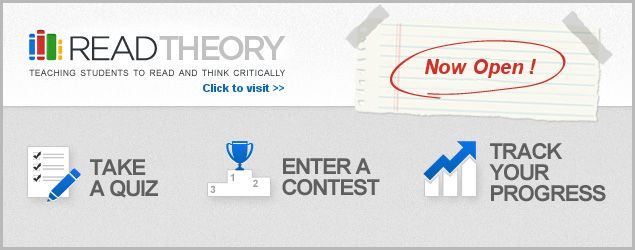
Critical Thinking Reading Comprehension Worksheets
- Take these as online quizzes here!
Short Story Reading Comprehension Worksheets
- Beginning Level
- Answers for this series are included at the end of each worksheet.
- "My Friend" - Low Beginning. 3 answer choices. 7 questions. 74 words.
- "My House" - Low Beginning. 3 answer choices. 7 questions. 92 words.
- "Time to..." - Low Beginning. 4 answer choices. 11 questions. 89 words.
- "My Family" - Low Beginning. 4 answer choices. 6 questions. 90 words.
- "Rainy Day" - Low Beginning. 4 answer choices. 5 questions. 78 words.
- "A Call to the Pool" - Low Beginning. 4 answer choices. 5 questions. 116 words.
- "The Singing Bird" - Low Beginning. 4 answer choices. 5 questions. 96 words.
- "Seeing Stars" - Low Beginning. 4 answer choices. 8 questions. 92 words.
- "I Fly" - Low Beginning. 4 answer choices. 4 questions. 113 words.
- "The Drive" - Mid Beginning. 4 answer choices. 10 questions. 120 words.
- "Zach's Animals" - Mid Beginning. 4 answer choices. 10 questions. 104 words.
- "Griffin's Talents" - Mid Beginning. 4 answer choices. 9 questions. 112 words.
- "A Happy Visitor" - Mid Beginning. 4 answer choices. 5 questions. 170 words.
- "An Adventure" - Mid Beginning. 4 answer choices. 5 questions. 177 words.
- "Running" - Mid Beginning. 4 answer choices. 5 questions. 148 words.
- "Paul Cooks" - Mid Beginning. 4 answer choices. 10 questions. 112 words.
- "Bella Hides" - Mid Beginning. 4 answer choices. 8 questions. 135 words.
- "First Prize" - Mid Beginning. 4 answer choices. 8 questions. 155 words.
- "What Number?" - Mid Beginning. 4 answer choices. 12 questions. 154 words.
- "The Interview" - High Beginning. 4 answer choices. 9 questions. 205 words.
- "Julian's Work" - High Beginning. 4 answer choices. 12 questions. 194 words.
- "Talia's Special Day" - High Beginning. 4 answer choices. 10 questions. 204 words.
- "One Hundred Dollars" - High Beginning. 4 answer choices. 13 questions. 273 words.
- "New Shoes for Maddy" - High Beginning. 4 answer choices. 11 questions. 223 words.
- "The 20" - High Beginning. 4 answer choices. 12 questions. 256 words.
- "Big City Noise" - High Beginning. 4 answer choices. 13 questions. 238 words.
- Intermediate Level
- "By the Water" - Low Intermediate. 4 answer choices. 9 questions. 225 words.
- "A Cold Day" - Low Intermediate. 4 answer choices. 14 questions. 286 words.
- "Vet Emergency!" - Low Intermediate. 4 answer choices. 10 questions. 247 words.
- "Late" - Low Intermediate. 4 answer choices. 14 questions. 284 words.
- "The Brenners" - Low Intermediate. 4 answer choices. 13 questions. 297 words.
- "Bullied" - Low Intermediate. 4 answer choices. 13 questions. 197 words.
- "The New School" - Low Intermediate. 4 answer choices. 14 questions. 286 words.
- "The Park" - Low Intermediate. 4 answer choices. 11 questions. 297 words.
- "Worth Working For" - Mid Intermediate. 4 answer choices. 10 questions. 280 words.
- "The Rent Man" - Mid Intermediate. 4 answer choices. 12 questions. 215 words.
- "Time with Grandpa" - Mid Intermediate. 4 answer choices. 9 questions. 237 words.
- "The Bus Driver" - Mid Intermediate. 4 answer choices. 15 questions. 294 words.
- "A Day Like No Other" - Mid Intermediate. 4 answer choices. 12 questions. 305 words.
- "A Mystery" - Mid Intermediate. 4 answer choices. 10 questions. 247 words.
- "Just One Touch" - Mid Intermediate. 4 answer choices. 15 questions. 326 words.
- "Wanga" - Mid Intermediate. 4 answer choices. 13 questions. 340 words.
- "Ana Finds an Apartment" - Mid Intermediate. 4 answer choices. 12 questions. 408 words.
- "Guermo's Surprise" - High Intermediate. 4 answer choices. 9 questions. 372 words .
- "Canopy of Nature" - High Intermediate. 4 answer choices. 8 questions. 332 words .
- "Blizzard in Birmingham" - High Intermediate. 4 answer choices. 10 questions. 319 words.
- "A Christmas in March" - High Intermediate. 4 answer choices. 10 questions. 385 words.
- "Bail" - High Intermediate. 4 answer choices. 10 questions. 301 words.
- "Clean Water Act" - High Intermediate. 4 answer choices. 10 questions. 632 words.
- "BB" - High Intermediate. 4 answer choices. 10 questions. 511 words .
- Advanced Level
- "The Mini Problem" - Low Advanced. 4 answer choices. 10 questions. 291 words .
- "Flower Power" - Low Advanced. 4 answer choices. 10 questions. 368 words.
- "Seeing Clearly" - Low Advanced. 4 answer choices. 10 questions. 284 words .
- "Accused" - Low Advanced. 4 answer choices. 12 questions. 285 words.
- "City Girl" - Low Advanced. 4 answer choices. 13 questions. 429 words.
- "Fried" - Mid Advanced. 4 answer choices. 10 questions. 235 words.
- "Tattoo" - Mid Advanced. 4 answer choices. 11 questions. 350 words.
- "The Transfers" - Mid Advanced. 4 answer choices. 12 questions. 381 words.
- "Wild" - Mid Advanced. 4 answer choices. 10 questions. 493 words.
- "Scorpion" - Low Advanced. 4 answer choices. 10 questions. 333 words
- "Remains of a Marriage" - Mid Advanced. 4 answer choices. 11 questions. 345 words.
- "Museum Hours" - Mid Advanced. 4 answer choices. 10 questions. 179 words.
- "Seeing Through" - High Advanced. 5 answer choices. 10 questions. 326 words.
- "Ursula Pugh" - High Advanced. 5 answer choices. 8 questions. 324 words.
- "Dreams" - High Advanced. 4 answer choices. 12 questions. 357 words.
- "Tracks" - High Advanced. 5 answer choices. 11 questions. 531 words.
- "Love Train" - High Advanced. 5 answer choices. 12 questions. 646 words.
- "The Storm" - High Advanced. 4 answer choices. 12 questions. 407 words.
Informational Passages Reading Comprehension Worksheets
In these reading comprehension worksheets, students are asked questions about information they have read about a specific topic. each passage reads similar to a newspaper of journal article, and provides interesting information about some aspect of history, nature, mechanics, science, art, and more. questions involve critical thinking with a focus on logic and inference..
- Answer Key - This answer key is available but still under development.
- "The Sun" - Low Beginning. 3 questions. Under 50 words.
- "Gas" - Low Beginning. 3 questions. Under 50 words.
- "Music" - Low Beginning. 4 questions. Under 50 words.
- "Birds" - Low Beginning. 4 questions. Under 50 words.
- "The Heart" - Low Beginning. 4 questions. Under 50 words.
- "The Butterfly" - Low Beginning. 5 questions. Under 50 words.
- "Pigs" - Low Beginning. 3 questions. Under 50 words.
- "The Brain" - Low Beginning. 3 questions. Under 50 words.
- "The Ocean" - Low Beginning. 7 questions. Under 100 words.
- "Trees" - Low Beginning. 4 questions. Under 100 words.
- "Alligators" - Low Beginning. 6 questions. Under 100 words.
- "The Blow-Dryer" - Low Beginning. 5 questions. Under 100 words.
- "Green Grass" - Low Beginning. 6 questions. Under 100 words.
- "Taste" - Low Beginning. 4 questions. Under 100 words.
- "Bees" - Mid Beginning. 10 questions. Under 200 words.
- "Frogs" - Mid Beginning. 10 questions. Under 200 words.
- "Beds" - Mid Beginning. 10 questions. Under 200 words.
- "Humans" - Mid Beginning. 10 questions. Under 200 words.
- "Fish" - Mid Beginning. 10 questions. Under 200 words.
- "Houses" - Mid Beginning. 10 questions. Under 300 words.
- "Soda Pop" - High Beginning. 10 questions. Under 200 words.
- "Tea" - High Beginning. 10 questions. Under 200 words.
- "Ice Fishing" - High Beginning. 10 questions. Under 300 words.
- "Bears" - High Beginning. 10 questions. Under 300 words.
- "Flags" - High Beginning. 10 questions. Under 300 words.
- "Leonardo Da Vinci" - High Beginning. 10 questions. Under 300 words..
- "Tennis" - High Beginning. 10 questions. Under 300 words.
- "Dogs" - High Beginning. 10 questions. Under 300 words.
- "Money" - High Beginning. 10 questions. Under 300 words.
- "Abraham Lincoln" - High Beginning. 10 questions. Under 300 words.
- "Corn" - High Beginning. 10 questions. Under 300 words.
- "Umbrellas" - High Beginning. 10 questions. Under 300 words.
- "Ben Franklin" - High Beginning. 10 questions. Under 300 words.
- "Cars" - High Beginning. 10 questions. Under 300 words.
- Answer Key - This is the answer key for to the intermediate level informational passages.
- "Helicopters" - Low Intermediate. 10 questions. Under 300 words.
- "Yellowstone National Park" - Low Intermediate. 10 questions. Under 400 words.
- "Empress of the Blues" - Low Intermediate. 10 questions. Under 400 words.
- "The Cactus" - Low Intermediate. 10 questions. Under 400 words.
- "Space Exploration Voyagers 1 and 2" - Mid Intermediate. 10 questions. Under 400 words.
- "Television" - Mid Intermediate. 10 questions. Under 400 words.
- "Hibernation and Estivation" - Mid Intermediate. 10 questions. Under 400 words.
- "Marco Polo" - Mid Intermediate. 10 questions. Under 400 words.
- "Movie Ratings" - Mid Intermediate. 10 questions. Under 400 words.
- "Birdsongs" - Mid Intermediate. 10 questions. Under 400 words.
- "Counting" - Mid Intermediate. 10 questions. Under 400 words.
- "Easter Island" - High Intermediate. 10 questions. Under 400 words.
- "Mosquitoes" - High Intermediate. 12 questions. Under 700 words.
- "Fingerprints" - High Intermediate. 11 questions. Under 700 words.
- "Mother's Day" - High Intermediate. 10 questions. Under 700 words.
- "Europe" - High Intermediate. 12 questions. Under 700 words.
- Answer Key - This is the answer key for to the advanced level informational passages.
- "Chocolate" - Low Advanced. 10 questions. Under 600 words.
- "Houses Around the World" - Low Advanced. 10 questions. Under 700 words.
- "Cells" - Low Advanced. 10 questions. Under 700 words.
- "Soccer" - Low Advanced. 12 questions. Under 700 words.
- "Bathtubs" - Low Advanced. 12 questions. Under 700 words.
- "Pollution" - Low Advanced. 12 questions. Under 700 words.
- "Interstate Highways" - Low Advanced. 10 questions. Under 800 words.
- "The U.S. Census" - Low Advanced. 10 questions. Under 800 words.
- "Sleep" - Low Advanced. 11 questions. Under 800 words.
- "The U.S. Postal Service" - Mid Advanced. 11 questions. Under 800 words.
- "Chemical Elements" - Mid Advanced. 11 questions. Under 800 words.
- "Africa" - Mid Advanced. 11 questions. Under 1000 words.
Technical Reading Comprehension Worksheets
In these reading comprehension worksheets, students are asked questions about the meaning, significance, intention, structure, inference, and vocabulary used in each passage. each passage reads like an encyclopedic or technical journal article. answers for worksheets in this section can be found at the end of each individual worksheet..
- "Water" - Beginning level. 3 questions with answers included. Under 300 words.
- "Paper" - Beginning level. 3 questions with answers included. Under 300 words.
- "The Flu" - Beginning level. 3 questions with answers included. Under 400 words.
- "Nuts" - Beginning level. 3 questions with answers included. Under 400 words.
- "The Sun" - Beginning level. 3 questions with answers included. Under 400 words.
- "The White House" - Beginning level. 3 questions with answers included. Under 400 words.
- "Soap" - Intermediate level. 3 questions with answers included. Under 400 words.
- "Clocks" - Intermediate level. 3 questions with answers included. Under 400 words.
- "The Robin" - Intermediate level. 3 questions with answers included. Under 400 words.
- "Hybrid Vehicles" - Intermediate level. 4 questions with answers included. Under 500 words.
- "Photography" - Intermediate level. 3 questions with answers included. Under 500 words.
- "Biomimetics" - Intermediate level. 4 questions with answers included. Under 700 words.
- "The Great Debates" - Intermediate level. 3 questions with answers included. Under 400 words.
- "Salt" - Advanced level. 3 questions with answers included. Under 700 words.
- "Colony Collapse" - Advanced level. 3 questions with answers included. Under 600 words.
- "Columbian Exchange" - Advanced level. 3 questions with answers included. Under 700 words.
- "Ethanol" - Advanced level. 3 questions with answers included. Under 600 words.
- "Generations" - Advanced level. 3 questions with answers included. Under 600 words.
- "The Hubble Telescope" - Advanced level. 7 questions with answers included. Under 1000 words.
- "Intellegence Augmentation" - Advanced level. 5 questions with answers included. Under 1000 words.
Role Play Reading Comprehension Worksheets
In these reading comprehension worksheets, students can increase their understanding of colloquial and idiomatic expressions and get a feel for conversational english. they also allow several students to participate at the same time - which makes them really fun great for use in school or at home..
- Answer Key - This is the answer key to the role play worksheets.
- "What Time Is It?" - Beginning Level. 4 questions. Under 100 words.
- "How Are You?" - Beginning Level. 4 questions. Under 100 words.
- "Tie Your Shoes!" - Beginning Level. 4 questions. Under 100 words.
- "Where Are My Glasses?" - Beginning Level. 4 questions. Under 100 words.
- "A Cookie" - Beginning Level. 4 questions. Under 100 words.
- "Where Are My Keys?" - Beginning Level. 4 questions. Under 100 words.
- "City Life, Country Life" - Beginning Level. 10 questions. Under 200 words.
- "Flu Shot" - Intermediate Level. 5 questions. Under 200 words.
- "Vinegar" - Intermediate Level. 4 questions. Under 200 words.
- "Wait for Me!" - Intermediate Level. 8 questions. Under 400 words.
- "Glasses" - Intermediate Level. 8 questions. Under 400 words.
- "Hungry" - Advanced Level. 8 questions. Under 400 words.
- "Want to Know a Secret?" - Advanced Level. 8 questions. Under 200 words.
- "Milk and Aesthetics" - Advanced Level. 8 questions. Under 500 words.
Dual Version Reading Comprehension Worksheets
In each of these reading comprehension worksheets, the same story is told, but with two versions: one that is basic, and one that is more advanced. this allows students to make direct comparisons between the advanced version to the more basic one, and makes for a powerful learning experience..
- Answer Key - Coming Soon!
- "An Overcast Day" - Beginning Level. 4 questions. Under 200 words.
- "Who Knows My Name?" - Beginning Level. 4 questions. Under 200 words.
- "A Call to the Pool" - Beginning Level. 6 questions. Under 300 words.
- "Oh No!" - Beginning Level. 8 questions. Under 300 words.
- "An Adventure" - Beginning Level. 6 questions. Under 400 words.
- "Happy Birthday" - Beginning Level. 4 questions. Under 400 words.
- "My Family" - Beginning Level. 8 questions. Under 300 words.
- "My Family" - Beginning Level. 5 questions. Under 300 words.
- "Driving Directions" - Beginning Level. 6 questions. Under 400 words.
- "A Happy Visitor" - Beginning Level. 7 questions. Under 300 words.
- "The Singing Bird" - Intermediate Level. 10 questions. Under 300 words.
- "Violet Makes a Cake" - Intermediate Level. 8 questions. Under 400 words.
- "A Visit to the Doctor" - Intermediate Level. 7 questions. Under 400 words.
- "Making Dinner" - Intermediate Level. 8 questions. Under 400 words.
- "The Market" - Intermediate Level. 10 questions. Under 500 words.
- "Maria Gets Her License" - Intermediate Level. 8 questions. Under 500 words.
- "A Paper for School" - Advanced Level. 7 questions. Under 300 words.
- "A Birthday Surprise" - Advanced Level. 7 questions. Under 600 words.
- "Getting a New Job" - Advanced Level. 8 questions. Under 600 words.
- "The Dinner Party" - Advanced Level. 9 questions. Under 600 words.
Home | About | Privacy Policy | Terms of Use | Contact Us
Reading Worksheets, Spelling, Grammar, Comprehension, Lesson Plans
Reading Comprehension Worksheets Grades 1 - 10
Use our free, printable reading comprehension passage exercises to improve your student's reading skills! Recognizing letters and words is an important first step in learning to read. However, it is only a first step; it is vital that students comprehend, or understand, what they are reading. They must be able to get the meaning of the text: What is the author telling the reader? This is reading comprehension, and it is an essential skill for success in school and in the real world. Below are our reading comprehension worksheets grouped by grade, that include passages and related questions. Click on the title to view the printable activities in each grade range, or to read the details of each worksheet. They are free for use in the home or in the classroom. Be sure to check out our spelling words activities too!
1st Grade Reading Comprehension Worksheets
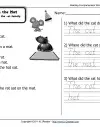
This 36 week first grade worksheet program for reading comprehension provides grade-appropriate passages and related questions, and can be used for other grades as appropriate.
2nd Grade Reading Comprehension Worksheets
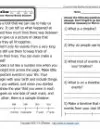
This 36 week second grade worksheet program for reading comprehension provides passages and questions that are grade appropriate, but can be used with additional grades.
3rd Grade Reading Comprehension Worksheets
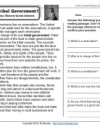
The 36 week third grade worksheet program for reading comprehension that we’ve organized here provides reading passages and activities designed for 3rd grade but can be used for other grades.
4th Grade Reading Comprehension Worksheets
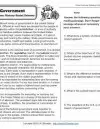
The 36 week fourth grade comprehension program that is included here provides reading passages and questions that are grade appropriate, but can be used with additional grades.
5th Grade Reading Comprehension Worksheets
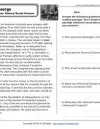
The 36 week fifth grade comprehension program provides passages and related questions that are grade appropriate, but can be used with additional grades.
6th Grade Reading Comprehension Worksheets
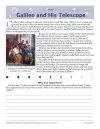
7th Grade Reading Comprehension Worksheets
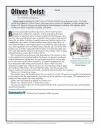
8th Grade Reading Comprehension Worksheets
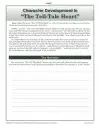
9th - 10th Grade Reading Comprehension Worksheets
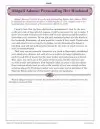
Improve your students’ Reading Comprehension It’s free.
Personalized reading comprehension exercises for K-12 and ESL students.
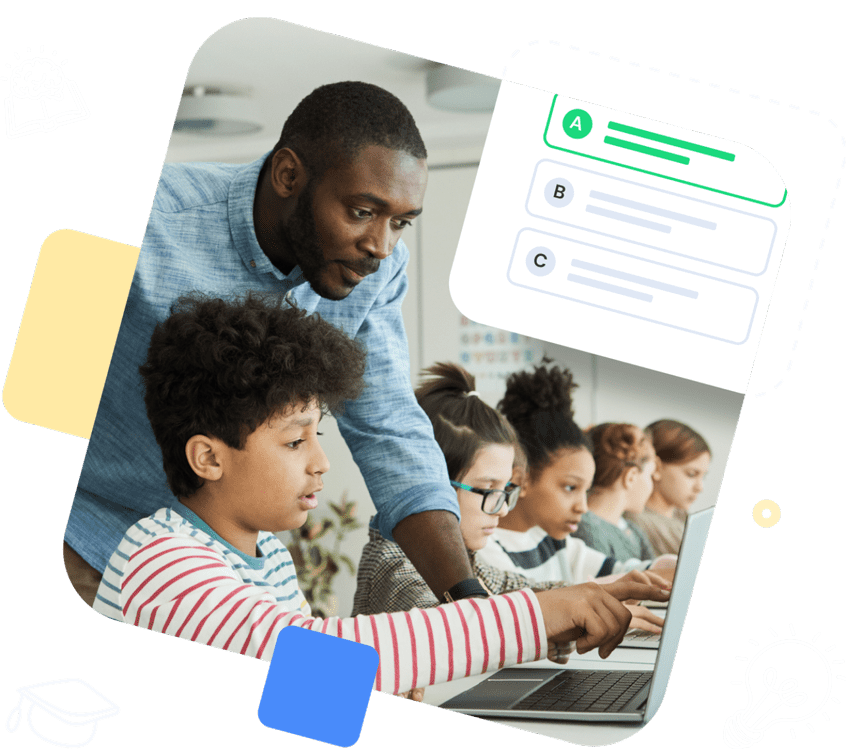
Around the world, millions of students are benefiting from ReadTheory.
- 18,000,000 Students
- 700,000 Teachers
- 40,000 Schools
scroll down to read more
Why use readtheory.
Reach students where they are with adaptive technology that adjusts to each student’s specific reading level.
Improve students’ reading comprehension with proven standards-aligned exercises for grades K-12.
Get up and running in minutes with an easy-to-use interface and human support when you need it.
Build classroom culture with interactive reading exercises and competitions that keep students engaged.
What educators are saying...
“ReadTheory is one of the best web tools out there for English Language Learners! I have ReadTheory to thank for bringing one of my students from a Grade 5 to a Grade 9 reading level in just 12 weeks!”
“Students learn by tracking their data and setting goals. It’s THE BEST comprehension intervention program I’ve used in over 30 years of teaching!”

“We started with a class average of 275 Lexile Level, and with ReadTheory we met our 600 Lexile Level goal!”
“I love the way the program automatically detects the student’s level and adjusts based on performance. I also love being able to track their progress and having solid data of the areas where they're struggling in reading.”
Try it right now
See for yourself how your students will experience ReadTheory!
Personalize learning for every student.
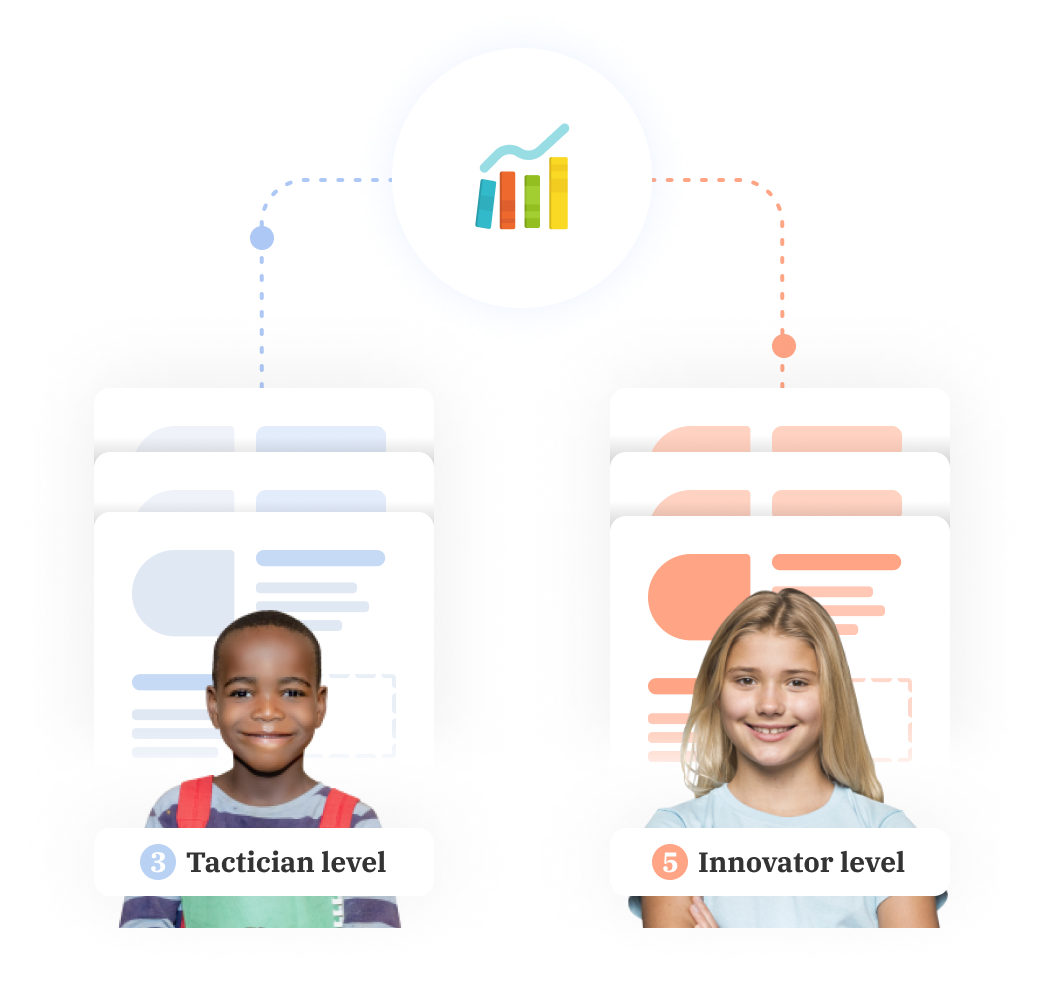
Teach multiple reading levels
Let our A.I driven software take over! We continuously note students’ performance and adapt the level of reading difficulty.
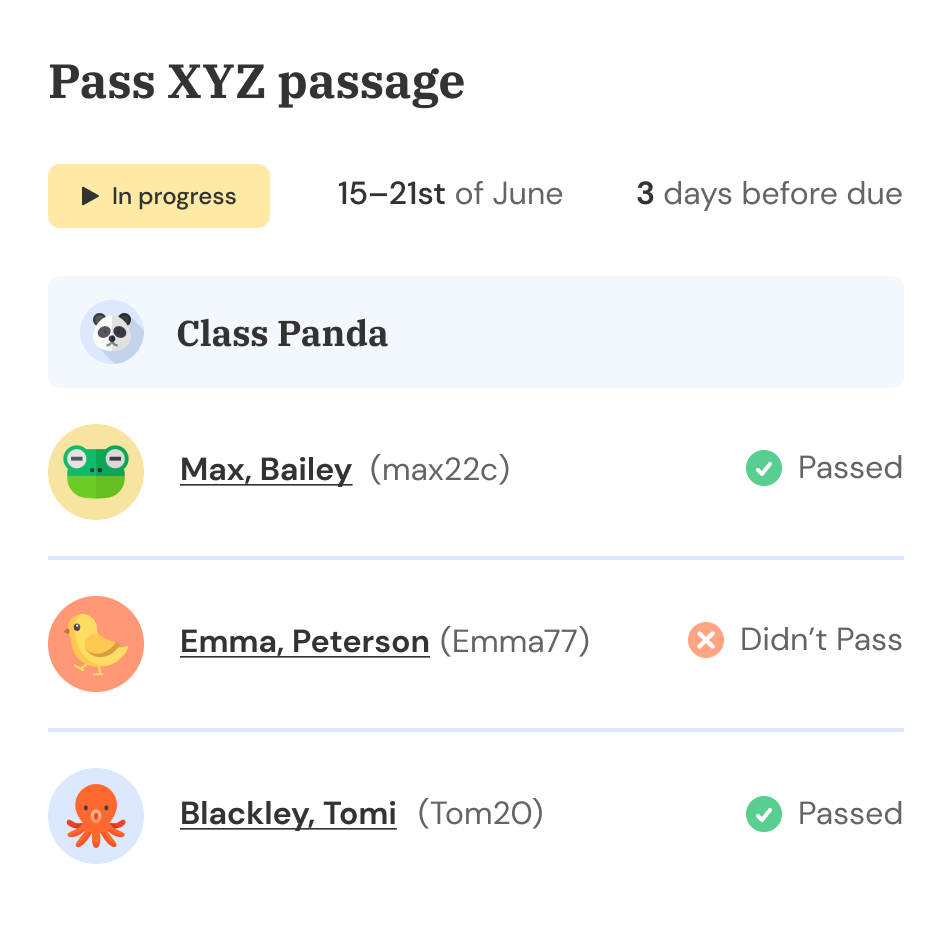
Save time with automatic marking
Put down the red pen, we’ve got you covered! Bonus points – set Recurring Activities once, and you’re good for the year!
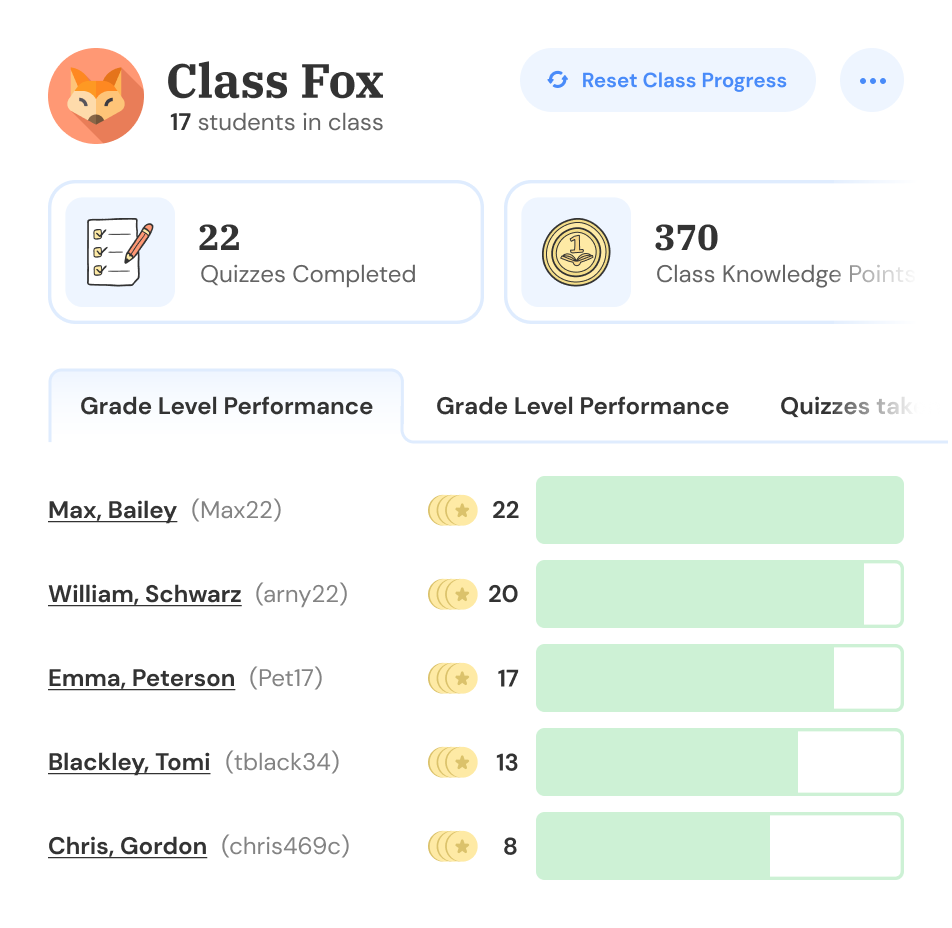
Easy-to-use reporting
Track individual student and class progress in real-time. Identify where additional practice is needed.
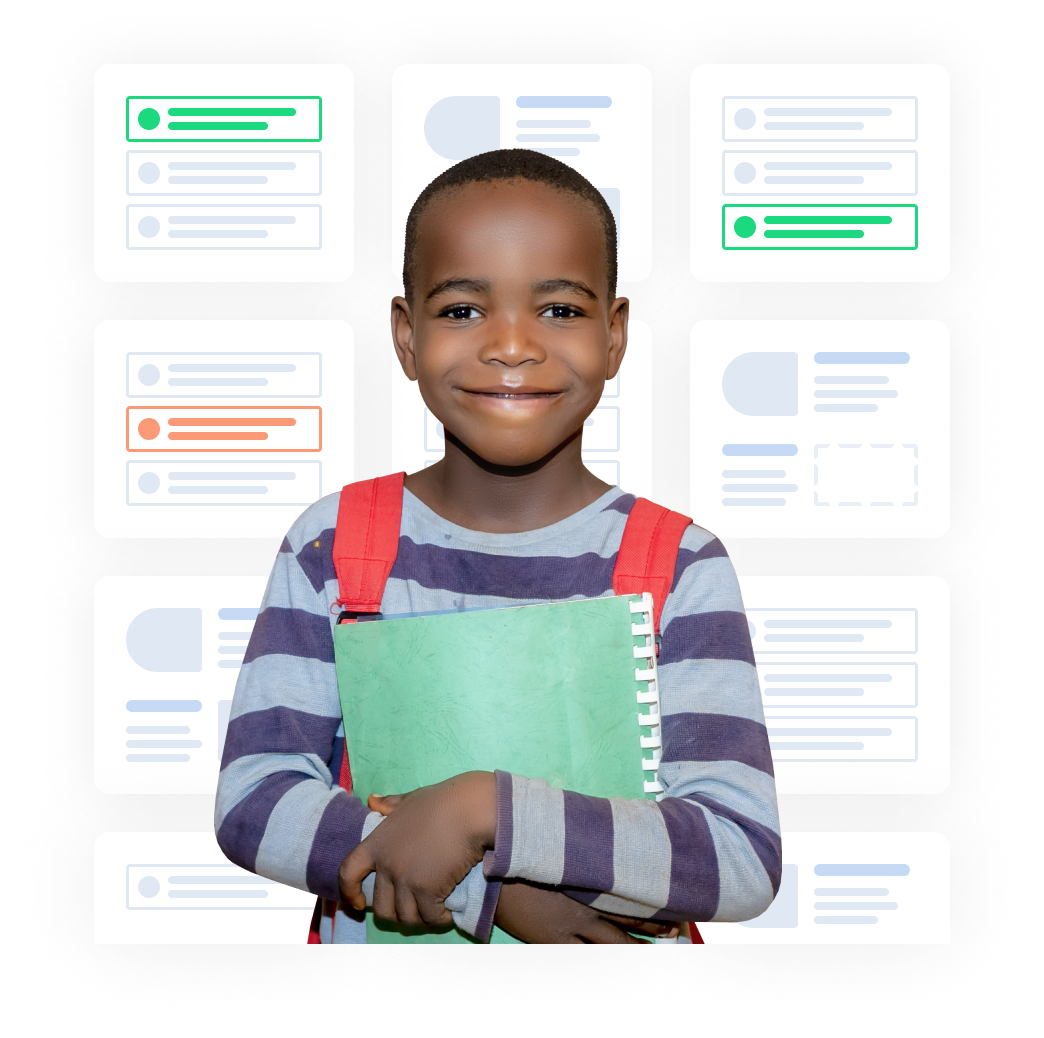
Access thousands of exercises
With thousands of interactive exercises and worksheets, you can find the perfect activity for your students.
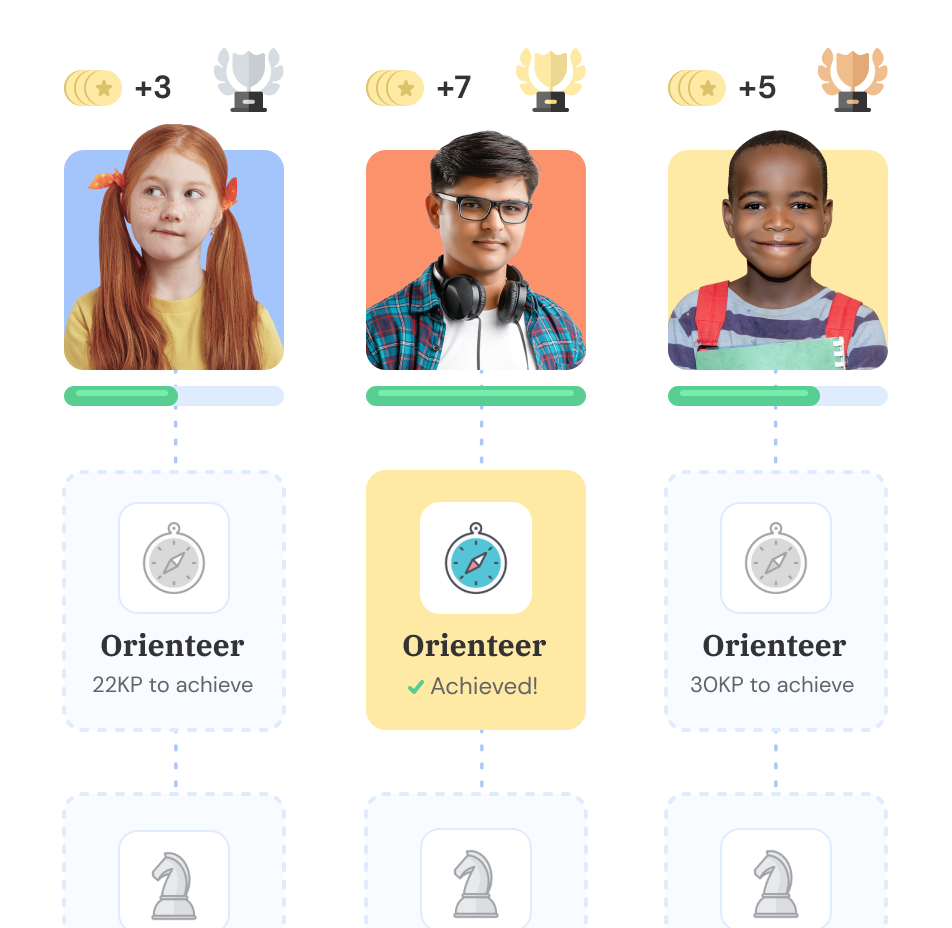
Win prizes and build class culture
Motivate students to read with engaging class competitions, badges, and prizes!
Rooted in research, proven in results
of teachers surveyed reported that ReadTheory contributed to an increase in standardized test scores.

of teachers said students are engaged and interested when using ReadTheory.
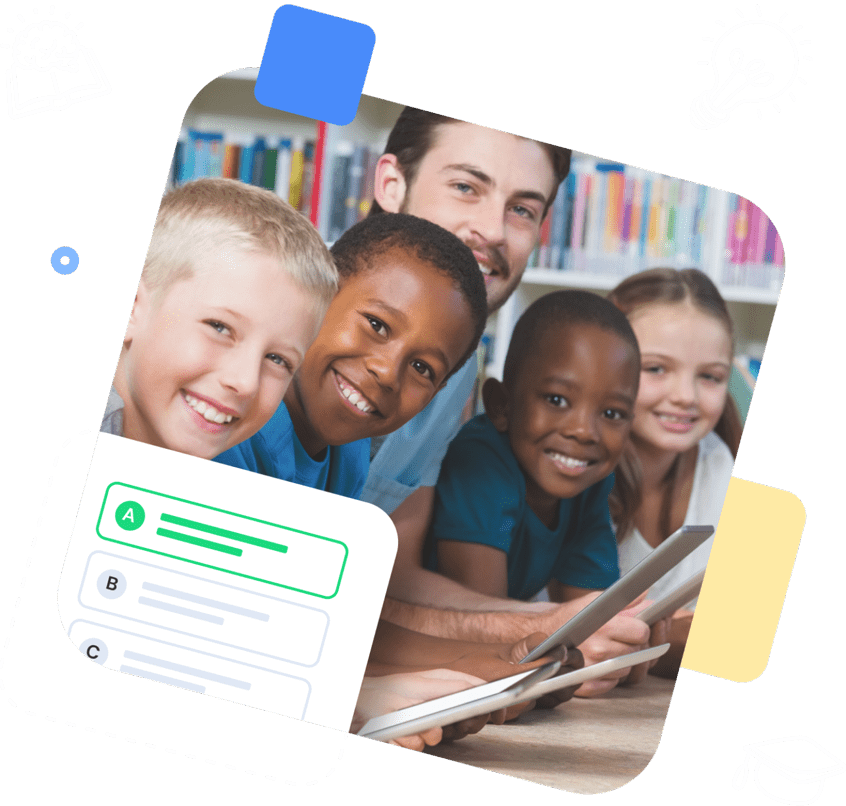
ReadTheory is free to use.
Register for an account now and be up and running in a couple of minutes.
Are you an admin looking to bring ReadTheory to your school or district?
Bring readtheory to your school or district.
If you're seeing this message, it means we're having trouble loading external resources on our website.
If you're behind a web filter, please make sure that the domains *.kastatic.org and *.kasandbox.org are unblocked.
To log in and use all the features of Khan Academy, please enable JavaScript in your browser.
Reading & language arts
2nd grade reading & vocabulary, 3rd grade reading & vocabulary, 4th grade reading & vocabulary, 5th grade reading & vocabulary, 6th grade reading & vocabulary, 7th grade reading & vocabulary, 8th grade reading & vocabulary, 9th grade reading & vocabulary, 6th grade reading and vocabulary (improved and expanded).

13 Fun Reading Activities for Any Book
Whether you walk into a classroom in Asia, North America or Europe, you will almost certainly see teachers and students building their understanding of the world through a dedicated daily reading session full of great reading activities.
Books allow students an opportunity to be informed, entertained or escape as they comprehend fiction and non-fiction texts against their understanding of the world, their personal insights, and opinions and finally compare those texts to others.
Whilst you may have a wealth of books in your school library, developing fresh and engaging ways to study literature can often be challenging. So today, we will explore 25 proven activities that can be applied to any book and at any age level.
These reading activities to improve reading comprehension are easy to follow and suitable for most age groups within an elementary/junior high school level.
125 Text Response ACTIVITIES, Games, Projects for ANY BOOK
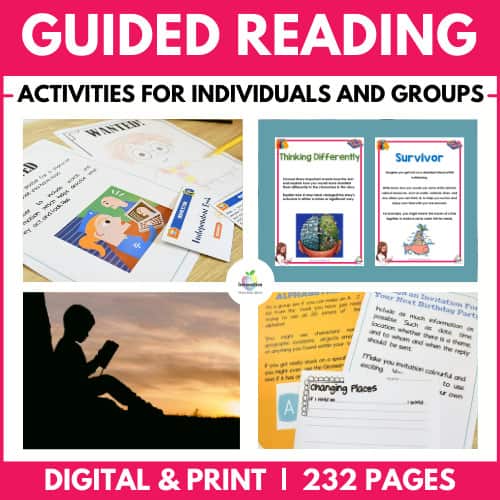
This massive collection of ☀️ READING ACTIVITIES☀️ covers all essential reading skills for elementary/primary students. NO PREP REQUIRED! Works with all text and media types.
Thousands of teachers have adopted this as a GO-TO RESOURCE for independent and group tasks.
A COLLECTION OF FUN READING ACTIVITIES
A lifetime tale in pictures reading task.
Draw the main character from a book you have recently read. Show them as a baby, middle-aged and an older person.
Underneath each picture, write what you think they might be doing at that point in their life, and explain why they may be doing so.
For example, if you drew Harry Potter as a baby, he might cast spells on his mum to feed him lots of yummy food.
Post-reading activities like this are accessible for all age groups to adapt their skill level and text style.
If you want to learn more about characters, read our complete guide here.
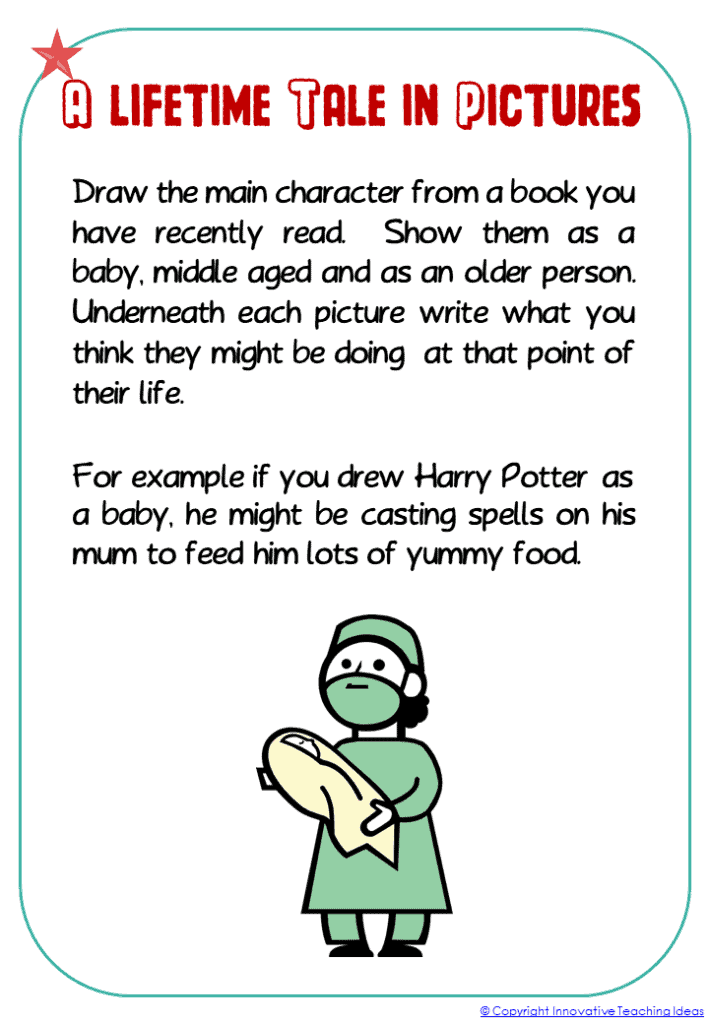
TEXT TO SELF-READING TASK
Based upon a book you have just read, share a story about yourself related to an event or character in the book.
It is probably best done in the form of a written recount. Link your experience to no more than four situations that occurred within the text.
Text to self is an excellent opportunity for students to become introspective about the content they read and compare it to their own life experiences.
This activity is appealing to teenagers more so than juniors .
IT’S IN THE INSTRUCTIONS READING TASK
From a book you have just read, select either a critical object or creature and create a user manual or a guide explaining how to care for it.
Ensure you use any vital information learnt from the book and any other information you consider essential.
If you are writing a user manual for an object, remember to focus on using it correctly and taking care of it.
If you are writing a user guide for an animal or creature, focus on keeping it alive and healthy as well as information that explains how to keep it happy and under control if necessary.
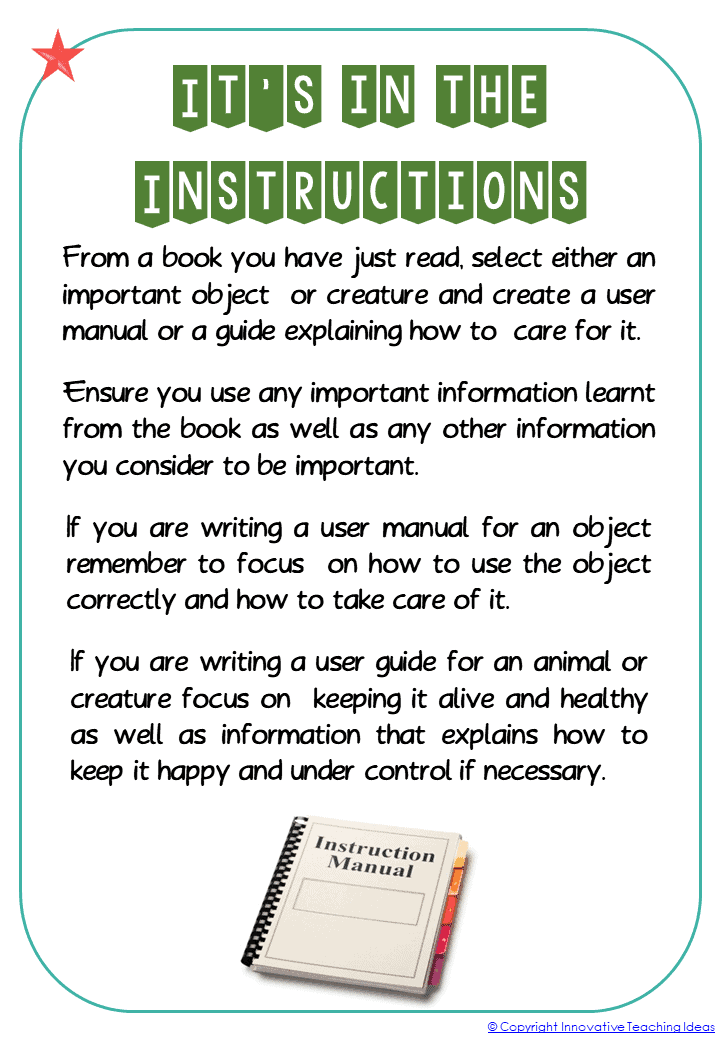
Dear Diary, READING TASK
Place yourself in the shoes of one of the characters you have just read about and write a diary entry of a critical moment from the story.
Try to choose a moment in the story where the character has plenty of interaction and emotion to share in a diary entry.
Your diary entry should be around a page long and contain information you learned from the book when the character was in that specific place and time.
Remember, when writing a diary entry, you are writing it from a first-person perspective. It is usually but not always written in the present tense.
Diary writing has been a very popular activity throughout time, but social media tools such as Facebook and blogging have in some ways changed this.
Mapping it all out, READING TASK
How do you make reading lessons fun? This reading activity answers that question confidently.
Have a go at drawing a map of one of the places from the text you have just read. See how much detail you can include, and be sure to discuss your map with another reader so you can compare and add more if necessary.
Take some time and effort to ensure your map appeals to the same audience the book aims at.
All good maps should contain the following BOLTS elements.
B – Bolts
O – Orientation
L – Legend
S – Scale

Express Yourself READING TASK
Using an iPad or a digital camera, make faces of the emotions the main characters would have gone through in your book and take photos of them.
Put them together in a document on your computer or device and explain the emotion below the image and when the character would have felt this way.
This is an excellent opportunity to use some creative direction for this task.
Be sure to play around with the images, filters and graphical styling available.
Travel Agent READING TASK
Think of yourselves as a group of travel assistants whose job is to promote a city of your choice from the text you have been reading.
As a group, you need to develop a concept map of all the exciting things that happen in your city and then present it to the class.
Don’t forget all of the exciting things such as theatres, restaurants, sports, adventure activities, entertainment and much more…
If you are a little short on details of the location of your story, do some research if it was an actual location or just get creative and make up some locations and tourist attractions based on what you read.
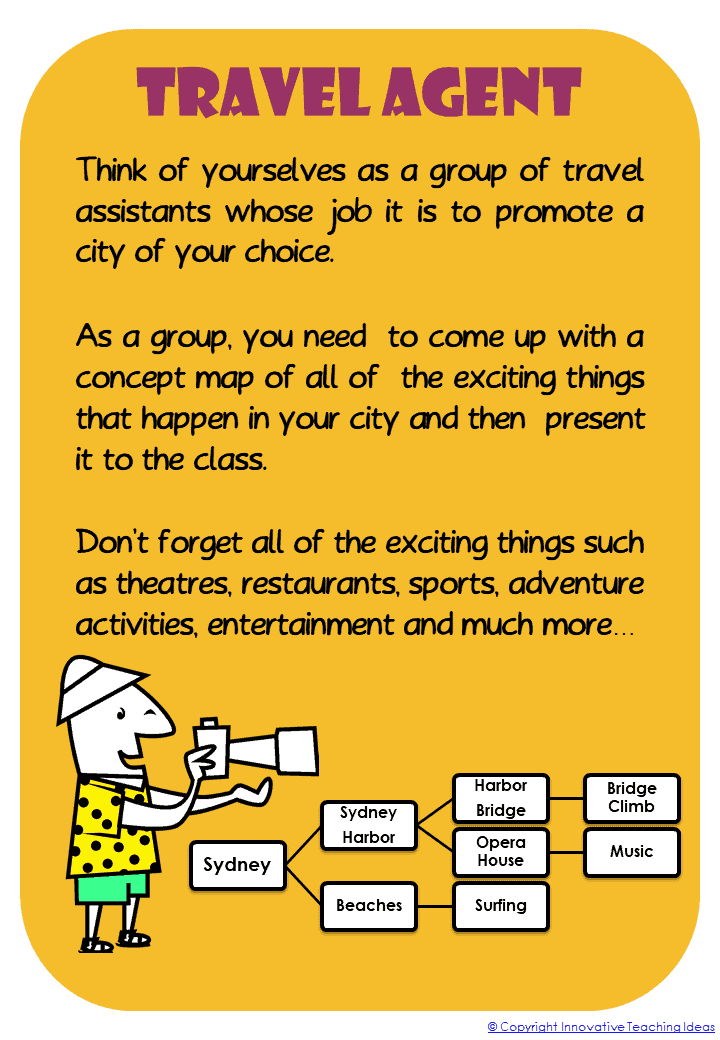
You’re Hired READING TASK
Select a character from a book and consider what might be an excellent job for them. You can choose something entirely suitable such as a security guard job for Superman or a more oddball approach, such as a pastry chef.
Either way, you will have to write a letter from this character’s perspective and apply for a position.
Be sure to explain why your character would be a great employee and what special skills they would possess to make them ideal for the role. Sell your character by explaining all the great attributes they possess.
What’s the Status? READING TASK
Create a Facebook page for your character with some status updates about what they have been up to.
Include some pictures and ensure your status updates are relevant to the character and the story.
Around 3 – 4 status updates with mages should give an overall picture of the character.
Use your status updates to explore what your character does for a job, leisure time, places they might go on vacation and the like.
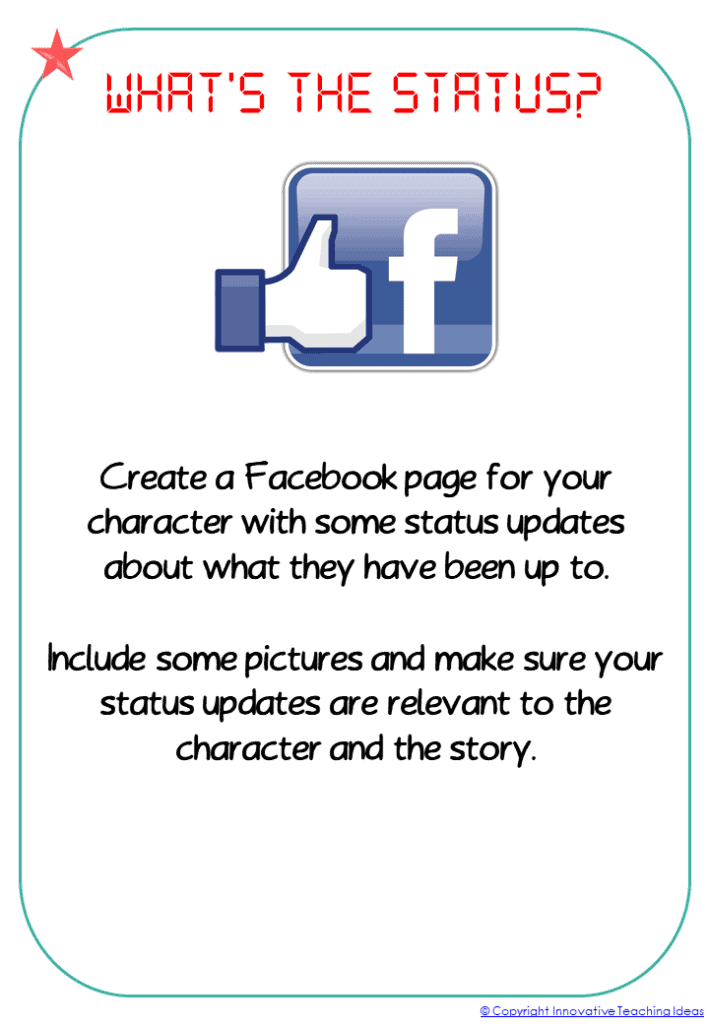
Bubbles and Clouds READING TASK
Using speech bubbles and pictures of the characters, draw a conversation between two characters from the story you have read.
Remember, thought is drawn as a cloud, and a spoken statement is drawn as a bubble.
Be sure to look at some comics or graphic novels for inspiration and insights.
This activity is usually best done on pen and paper, but numerous digital apps and tools will allow you to make this a reality through technology.
Amazing Artifacts READING TASK
An artifact is an object that has some significance or meaning behind it. Sometimes, an artefact might even have a very important story behind it. I am sure you have a favorite toy, or your parents have a particular item in the house that they would consider an important artifact.
For today’s task, you will select five artifacts from the text you have been reading and explain what makes them significant or essential.
They don’t all have to be super important to the story, but I am sure that at least a couple played a significant role.
Be sure to draw a picture of the artifact and if necessary, label it.

FREE READING ACTIVITIES RESOURCE TO DOWNLOAD
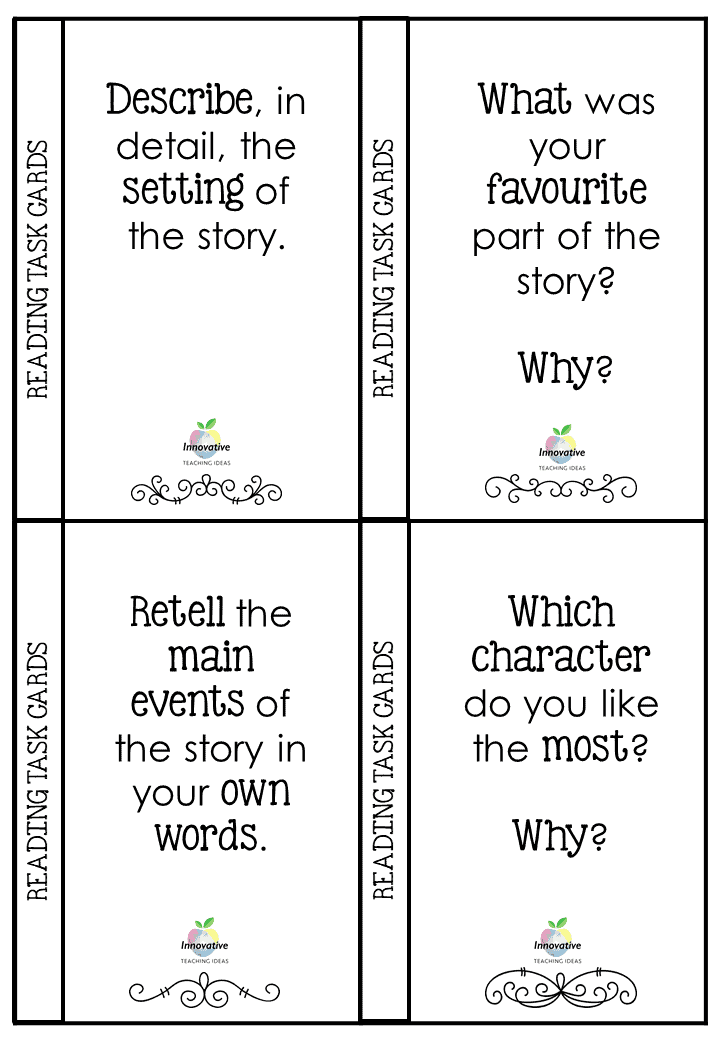
Thinking Differently READING TASK
Choose three important events from the text and explain how you would have handled them differently from the characters in the story.
Explain how it may have changed the story’s outcome in either a minor or significant way.
Be insightful here and think of the cause and effect. Sometimes your smallest action can have a significant impact on others.
Popplet Mind Mapping Task
Popplet is a mind mapping tool that allows you to connect ideas together using images, text and drawings.
From a text, you have recently read, create a family tree or network diagram that explains the relationship the characters have with each other.
Some may be father and son, husband and wife or even arch enemies.
Try and lay it out so it is easy to follow.
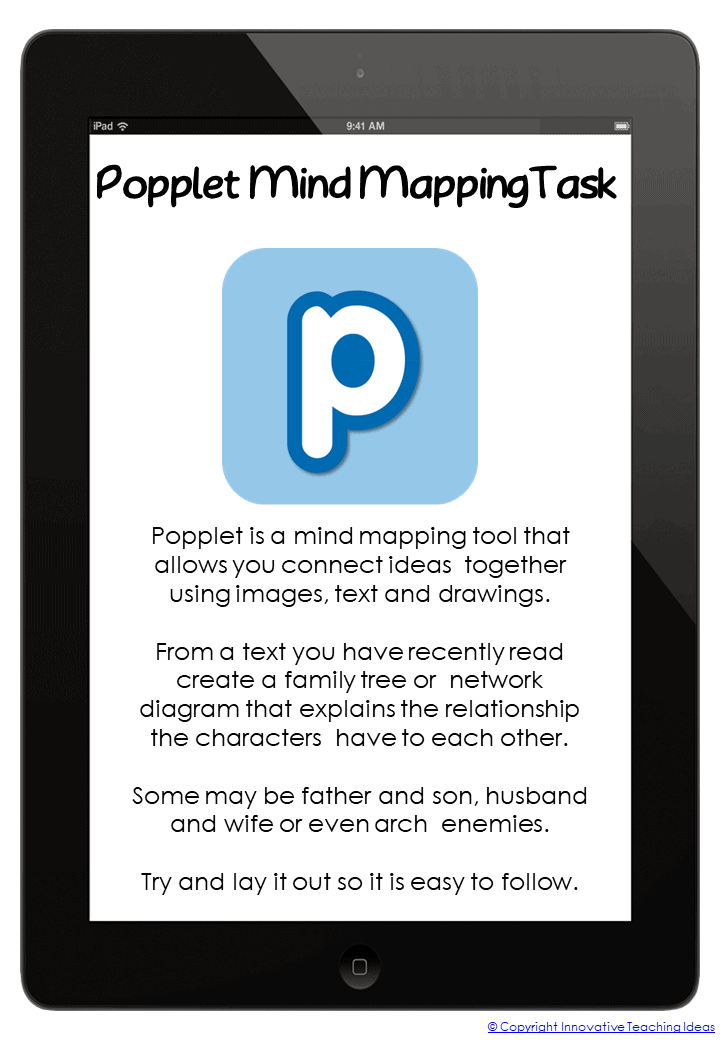
You Have Three Wishes READING TASK
A genie lands at the midpoint of the story you have just read and grants the two main characters three wishes.
What do they wish for and why?
Finally, would their wishes have changed anything about the story? How so?
Again think about the cause and effect relationship and how this may have altered the path of the book you have been reading.
A COMPLETE DIGITAL READING UNIT FOR STUDENTS
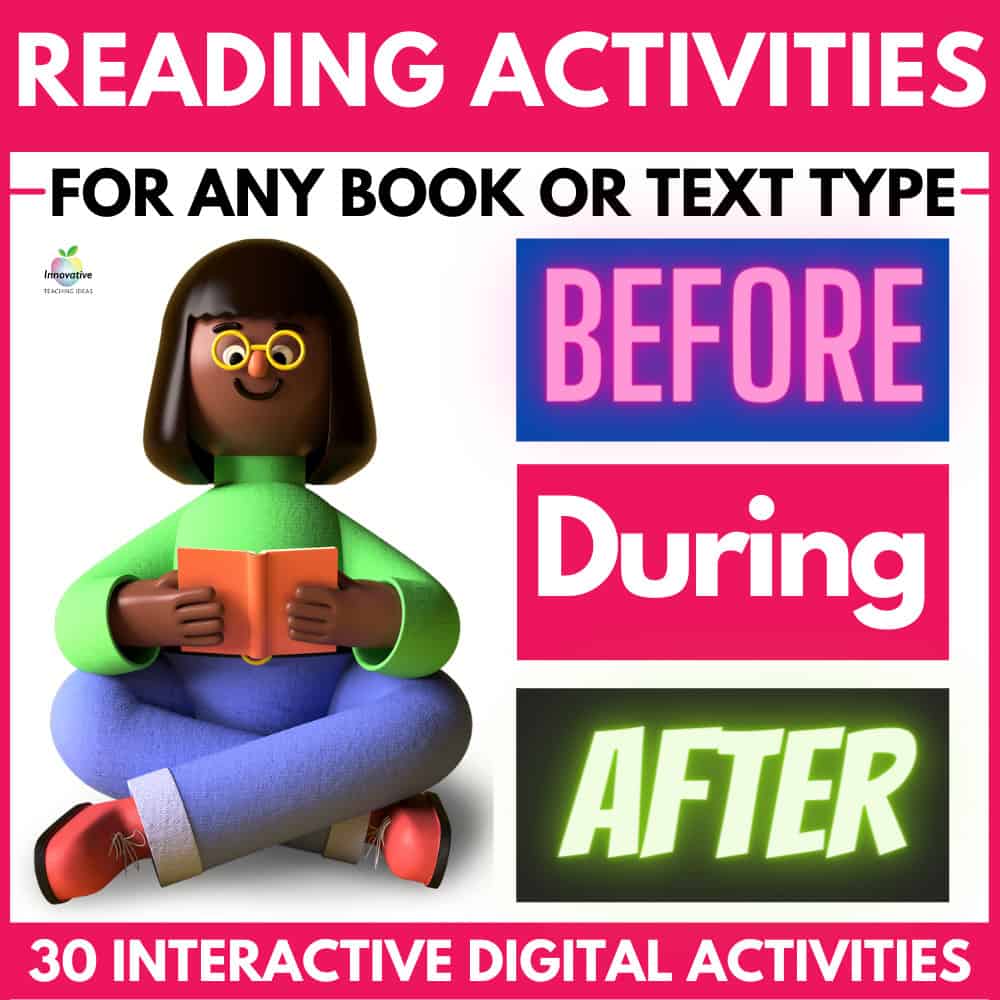
Over 30 engaging activities for students to complete BEFORE, DURING and AFTER reading ANY BOOK
- Compatible with all devices and digital platforms, including GOOGLE CLASSROOM.
- Fun, Engaging, Open-Ended INDEPENDENT tasks.
- 20+ 5-Star Ratings ⭐⭐⭐⭐⭐
MORE GREAT ARTICLES WITH READING ACTIVITIES

Top 7 Reading Comprehension Strategies for Students and Teachers

How to teach Guided Reading: Teaching Strategies and Activities
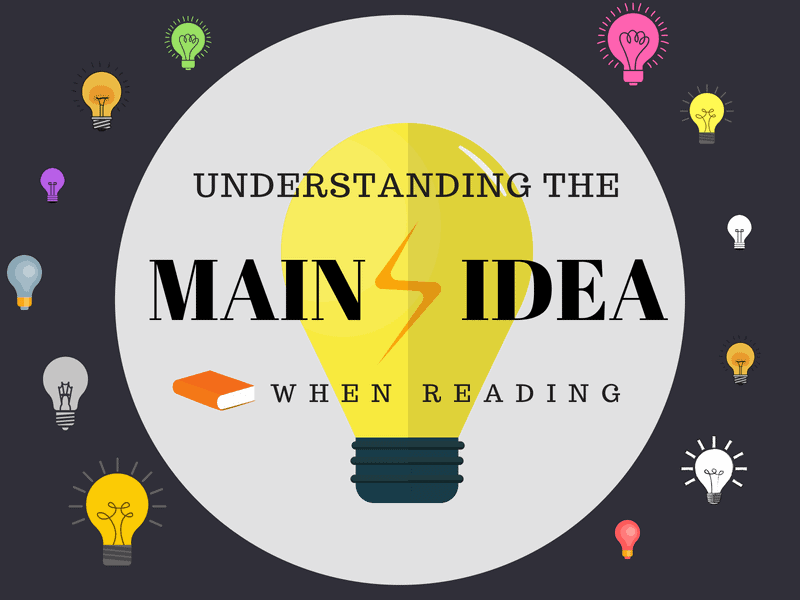
Identifying the main idea of the story: A Guide for Students and Teachers
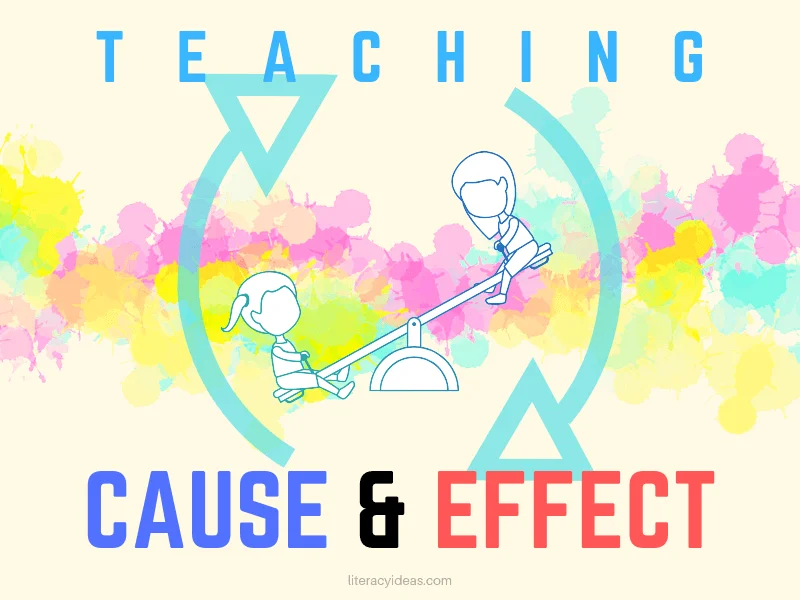
Teaching Cause and Effect in Reading and Writing
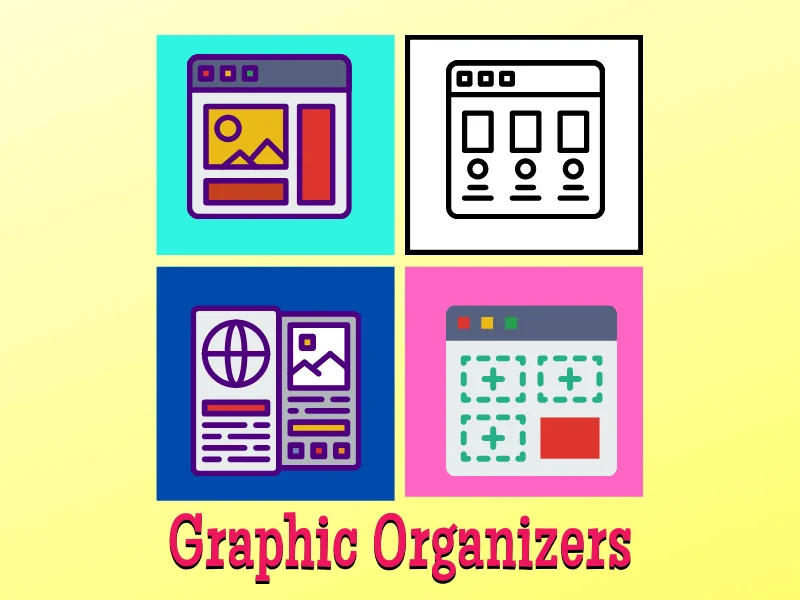
Graphic Organizers for Writing and Reading
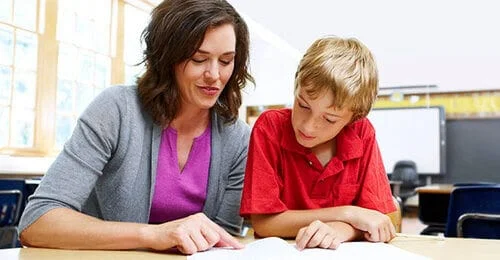
Top 7 Tips for Teaching Guided Reading in Large Classes

5 Reasons You Need a Digital Reading Diary In 2023

Reading & Math for K-5
- Kindergarten
- Learning numbers
- Comparing numbers
- Place Value
- Roman numerals
- Subtraction
- Multiplication
- Order of operations
- Drills & practice
- Measurement
- Factoring & prime factors
- Proportions
- Shape & geometry
- Data & graphing
- Word problems
- Children's stories
- Leveled Stories
- Context clues
- Cause & effect
- Compare & contrast
- Fact vs. fiction
- Fact vs. opinion
- Main idea & details
- Story elements
- Conclusions & inferences
- Sounds & phonics
- Words & vocabulary
- Reading comprehension
- Early writing
- Numbers & counting
- Simple math
- Social skills
- Other activities
- Dolch sight words
- Fry sight words
- Multiple meaning words
- Prefixes & suffixes
- Vocabulary cards
- Other parts of speech
- Punctuation
- Capitalization
- Narrative writing
- Opinion writing
- Informative writing
- Cursive alphabet
- Cursive letters
- Cursive letter joins
- Cursive words
- Cursive sentences
- Cursive passages
- Grammar & Writing
Breadcrumbs
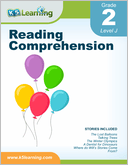
Download & Print Only $3.49
Second Grade Reading Comprehension Worksheets
Grade 2 reading comprehension.
Use these free, printable worksheets to practice and improve reading comprehension, vocabulary and writing. Each worksheet includes a short fiction or non-fiction passage followed by some questions. These worksheets are at a 2nd grade level.

Leveled stories & reading worksheets
These grade 2 leveled stories are taken from our series of leveled reading workbooks . Each successive level provides a greater reading challenge.
Children's stories
Over 20 free children's stories followed by comprehension questions. Most passages are 150-200 words long; questions ask students to recall what they have read.
Fables for grade 2 students
Each historical passage or fable is followed by 4 questions focused on recalling information directly from the text.
Reading comprehension exercises
Reading comprehension worksheets focused on specific comprehension topics such as the "main idea versus details" of a text, sequencing and story elements (characters, setting, plot).
We also have some short plays and drama exercises which can be fun way of building comprehension skills.
What is K5?
K5 Learning offers free worksheets , flashcards and inexpensive workbooks for kids in kindergarten to grade 5. Become a member to access additional content and skip ads.

Our members helped us give away millions of worksheets last year.
We provide free educational materials to parents and teachers in over 100 countries. If you can, please consider purchasing a membership ($24/year) to support our efforts.
Members skip ads and access exclusive features.
Learn about member benefits
This content is available to members only.
Join K5 to save time, skip ads and access more content. Learn More
- Forgot Password?
You are using an outdated browser. Please upgrade your browser to improve your experience.
- Grades 6-12
- School Leaders
Win a Yeti, gift cards, and more in Our Teacher Appreciation Giveaway 🎁!
23 Fun and Easy Guided Reading Activity Ideas
Boost reading skills in small groups.
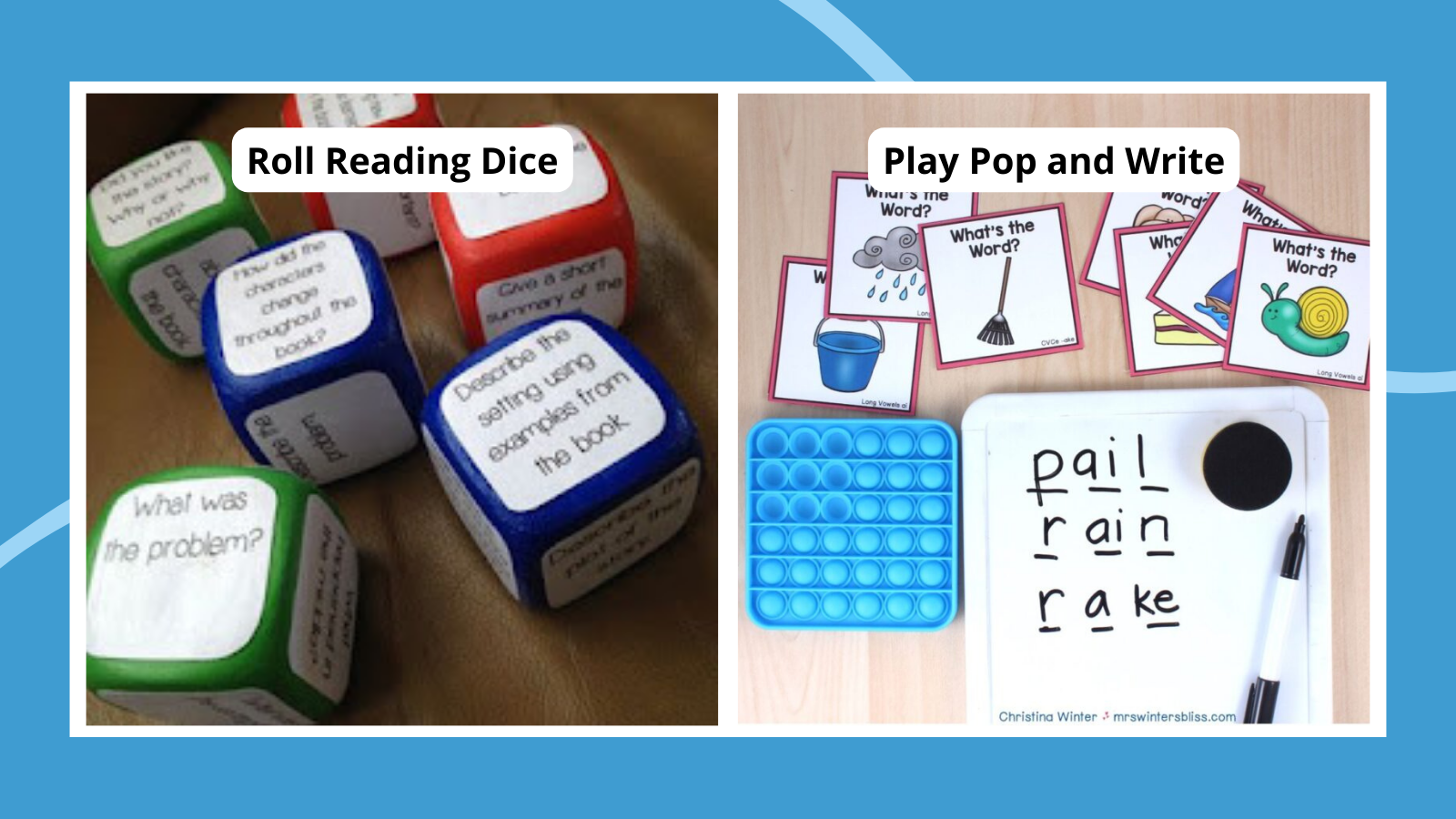
Guided reading is small-group instruction that supports each reader’s progress with mini-lessons, practice, and feedback. Students read books at their level and engage in activities before and after that help them build core reading skills. Read on to learn how to teach a guided reading lesson, plus see our favorite guided reading activity ideas.
What is included in a guided reading lesson?
You’ll use the same text across multiple guided reading lessons. Depending on the skills you’re teaching and the text, you may plan guided reading lessons that span a few days or a week. The point is to really get into the text and practice reading skills with your feedback and guidance.
Each guided reading lesson is broken into parts:
Mini lesson
A mini lesson that focuses on phonemic awareness, phonics, word reading, fluency, or vocabulary. You can’t hit all of those in one mini lesson, so choose a skill that students will be using in the text they’re reading right after the mini lesson.
Read the book
Students read the decodable book independently. They may whisper-read while you listen, or they may read on their own and read aloud when you ask them to. During this time, you check in with students to make sure they are able to read and understand the text.
Comprehension activities
After students have finished reading, it’s time to talk about what they read. They’ll retell, answer questions, and engage in other comprehension-based activities.
The last part of a guided reading lesson is applying the skills they learned in writing. This could mean practicing writing words from the story, or writing sentences or responses to the story.
Preparing for Guided Reading
Guided reading takes planning—lots of planning. Doing this work on the front end will make guided reading an effective, fun time in your reading block. Here are the three steps you can take to make guided reading work:
Get students into groups
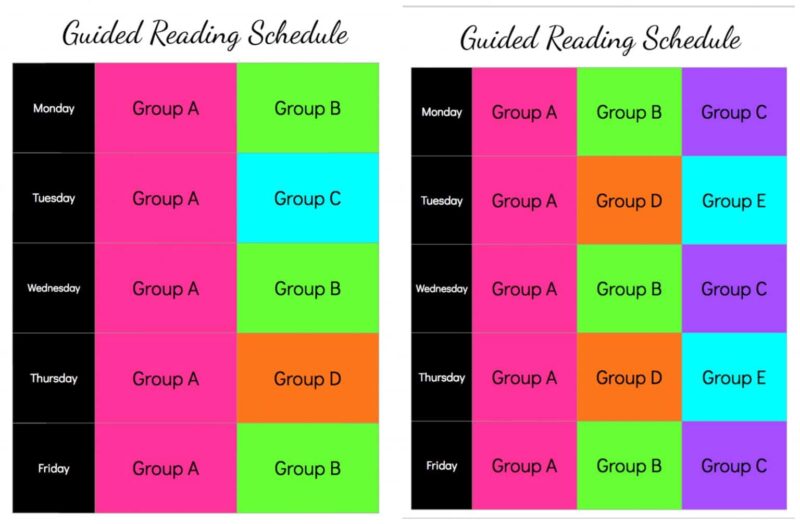
Ashleigh’s Education Journey/guided reading groups via Ashleigh-educationjourney.com
Use data from your school’s universal screening and other assessments to identify which students are working on the same thing for guided reading groups. Maybe you have a group of students who are working on long vowel patterns, while another group is working on reading multi-syllabic words. The text they read will give them a chance to practice what they’re learning, so it’s important to have the right groups.
Choose an appropriate text
Text selection is key during guided reading. Students should be working in text that they can just reach with support since they’re spending their reading time being closely monitored. Look for decodable texts, or texts that have words that students have learned. So, a short-“a” decodable reader would have words that only have the short “a” sound—it won’t include long “a” words or other vowels.
As students get older, finding books that they’re interested in reading continues to be important, but you’ll look for books that have features you want to teach, like text features or text structure.
Set the schedule
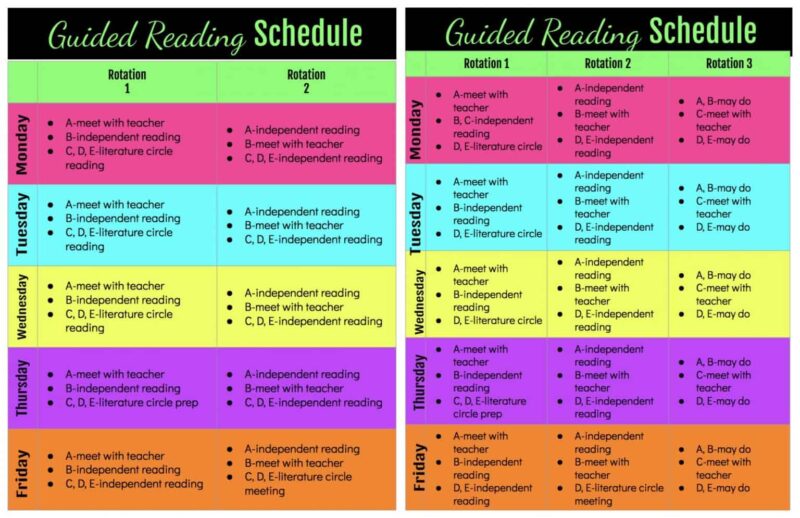
Ashleigh’s Education Journey/guided reading schedule
Set a schedule that ensures that each student gets what they need—students who are able to read and work more independently may need a different schedule than students who struggle to work on their own and need additional help with reading. A weekly schedule lets you make sure you’re hitting all the right skills and practice.
A guided reading schedule may also include intervention or Tier 2 groups. Read more about reading intervention .
Mini-Lesson Activities
Each guided reading lesson will start with a mini-lesson. You don’t have a lot of time, so focus on one aspect of reading that students are going to apply in the book that day.
Build and Write Words
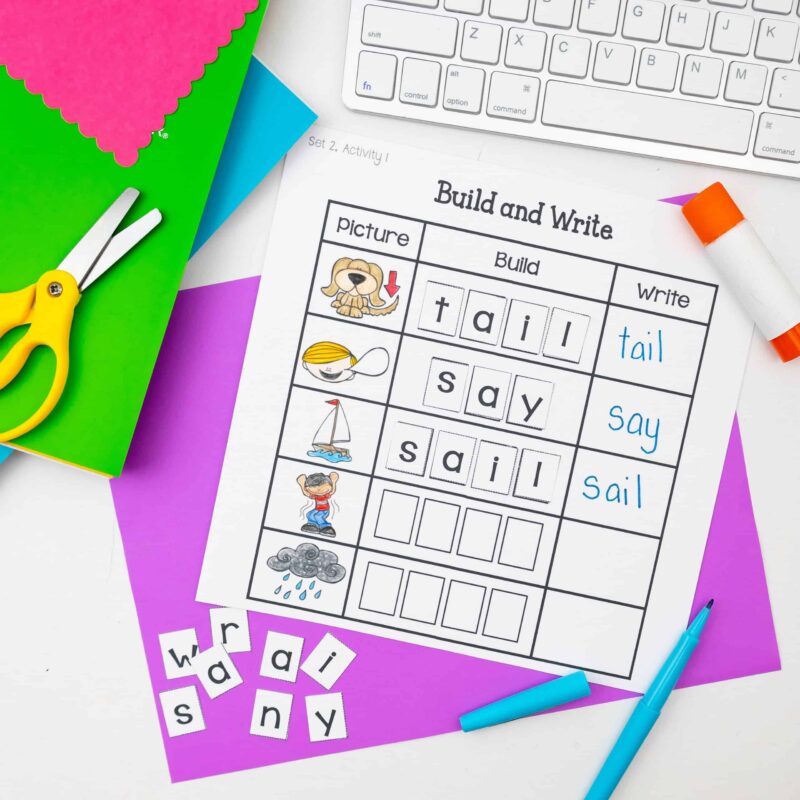
Ashleigh’s Education Journey/guided reading activity via Ashleigh-educationjourney.com
Give students practice forming words with letter tiles or cut-out letter squares. Students choose the letters they need to sound out words that they’ll read in the book. Then, with the model they’ve created, they can write the word in the next column.
Pop and Write
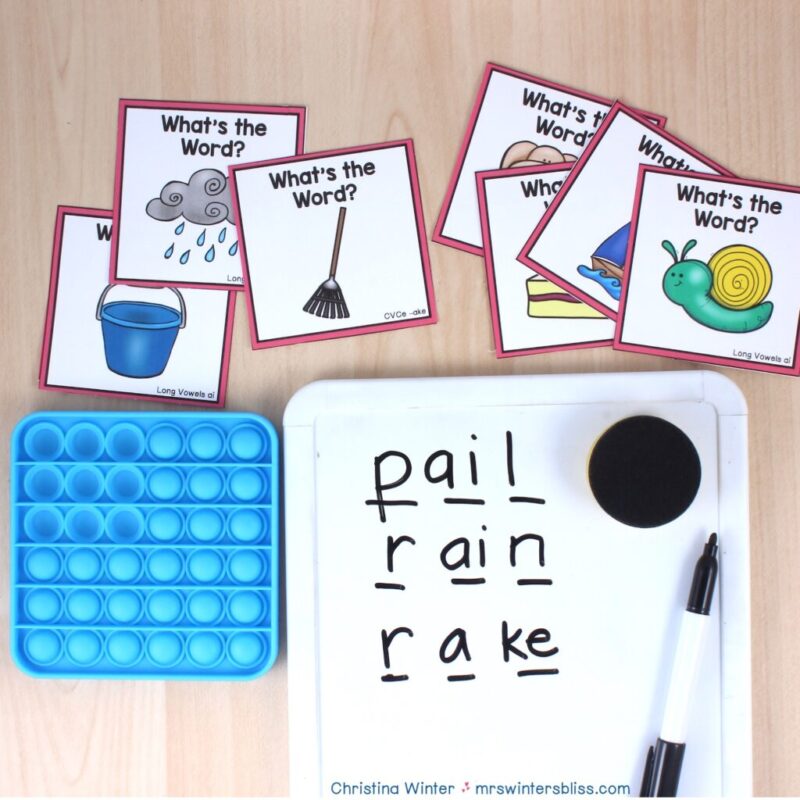
Mrs. Winter’s Bliss/word mapping activity via mrswintersbliss.com
In this guided reading activity, have students use a Pop-It to break a word into sounds. Then, students use a whiteboard marker to write the word. (Could you include more fun things in one activity?!) Combining the Pop-It for phonemic awareness and writing to practice encoding letter sounds is a great way to reinforce two skills at once.
CVC Word Reading
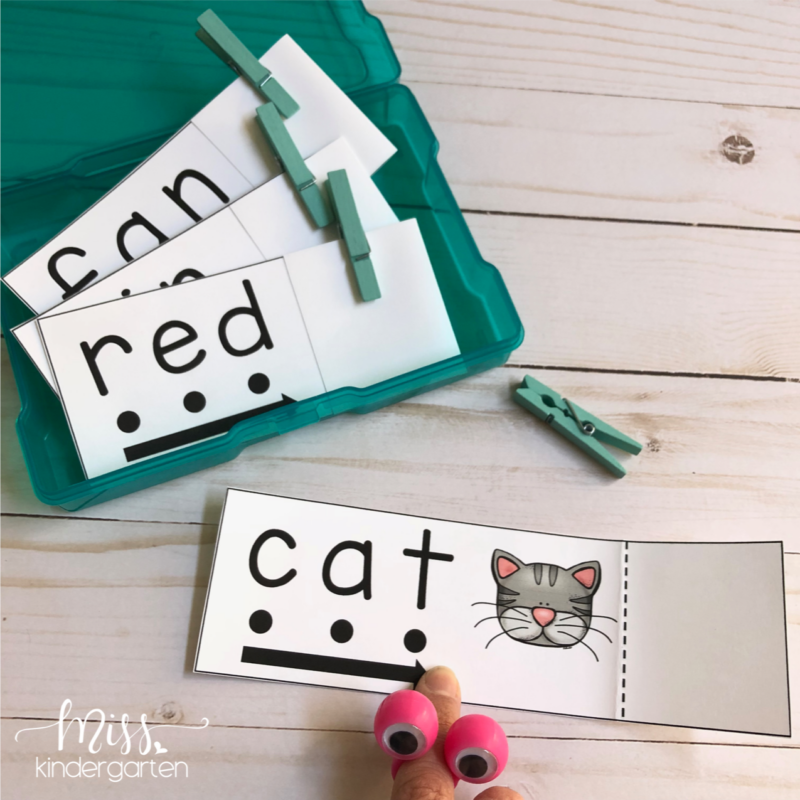
Miss Kindergarten/CVC word reading via misskindergarten.com
Use cards like these from Miss Kindergarten to practice pointing to and blending each sound in a word. Choose words that will be in the book students are reading and point out when they use the same strategy they use during the practice in their actual book reading.
Pre-Teach Vocabulary
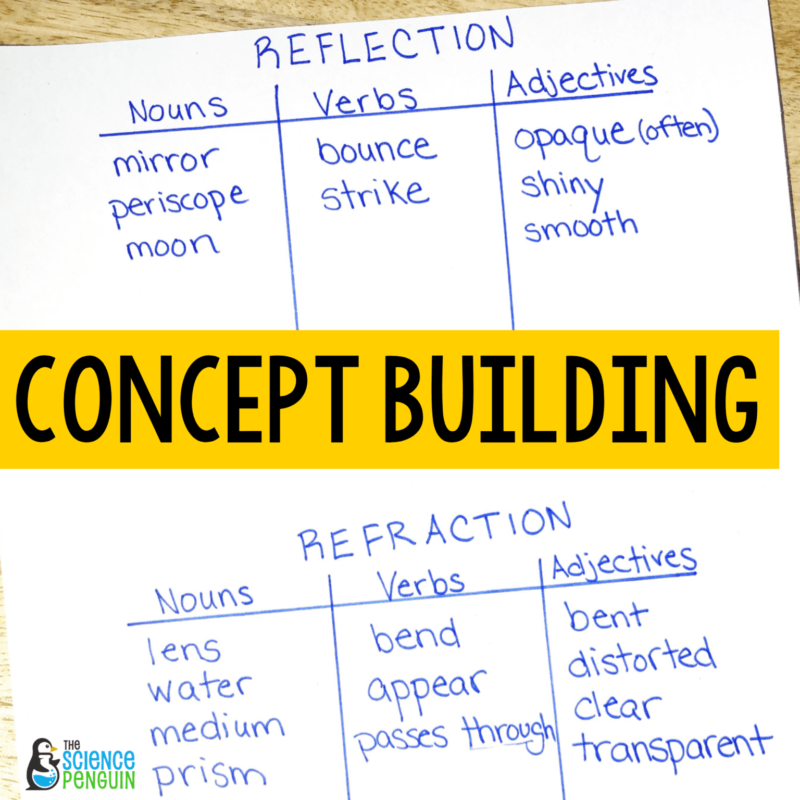
The Science Penguin/vocabulary concept building via thesciencepenguin.com
Help students start to organize and remember new vocabulary by having them work with words. In this example from The Science Penguin , students sort new words according to parts of speech to help commit them to memory.
Sight Word Sticker Book
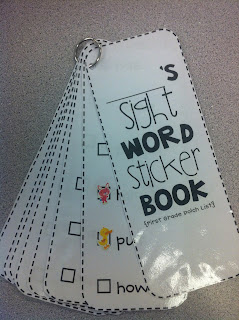
First Grader … at Last/sight word sticker book via Firstgraderatlast.blogspot.com
As students master sight words, have them put stickers by each word. Then, as a warm-up in guided reading, they can review the words they know and practice words they don’t. Set a day as sticker day, when they can prove that they’ve mastered a new word and add more stickers to their book.
Learn more: First Grader … at Last
Fluency Strips
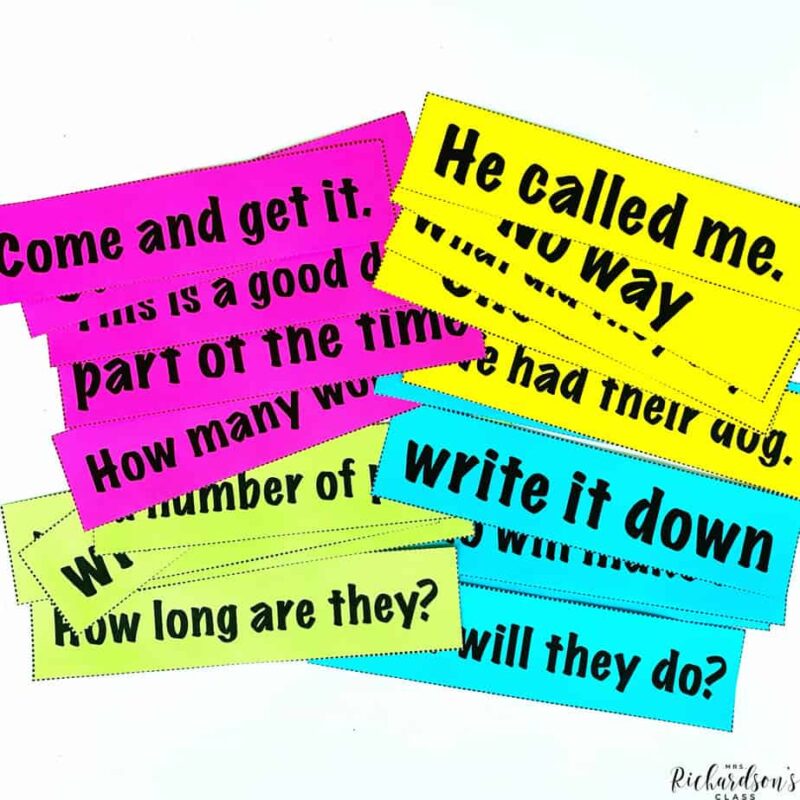
Mrs. Richardson’s Class/fluency Strips via mrsrichardsonsclass.com
In this guided reading activity, have students practice reading fluency with short, manageable strips of a phrase or a sentence or two. You can also print out sentences or short paragraphs from books they’re reading so you can build repeated reading practice into guided reading.
Learn more: Mrs. Richardson’s Class
Read more: Fluency Activities
Word Family Fluency
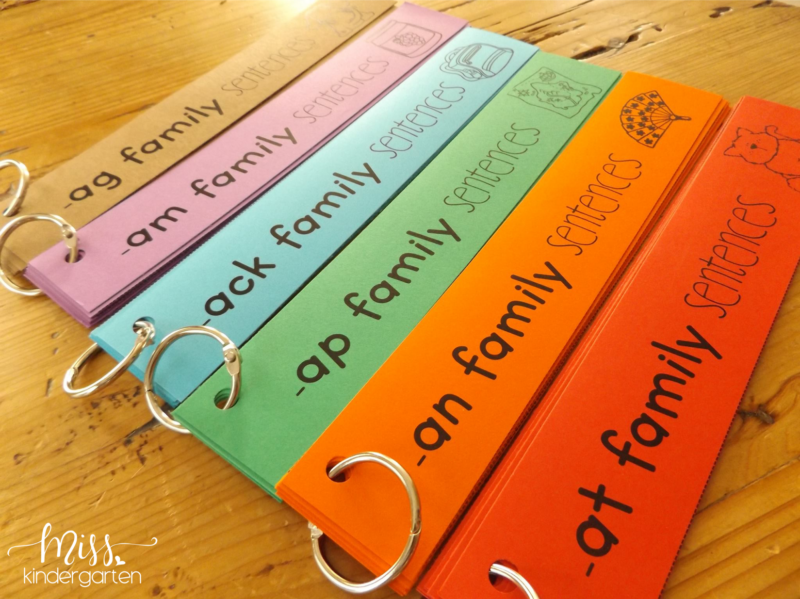
Miss Kindergarten/word family fluency via misskindergarten.com
Another way to work in some quick fluency practice is with word family sentence strips. Give students the strips for the word family they are working on and have them practice reading through the strips. If you organize them by color like Miss Kindergarten , you can also have a rainbow-sentence option with sentences from all the different word families.
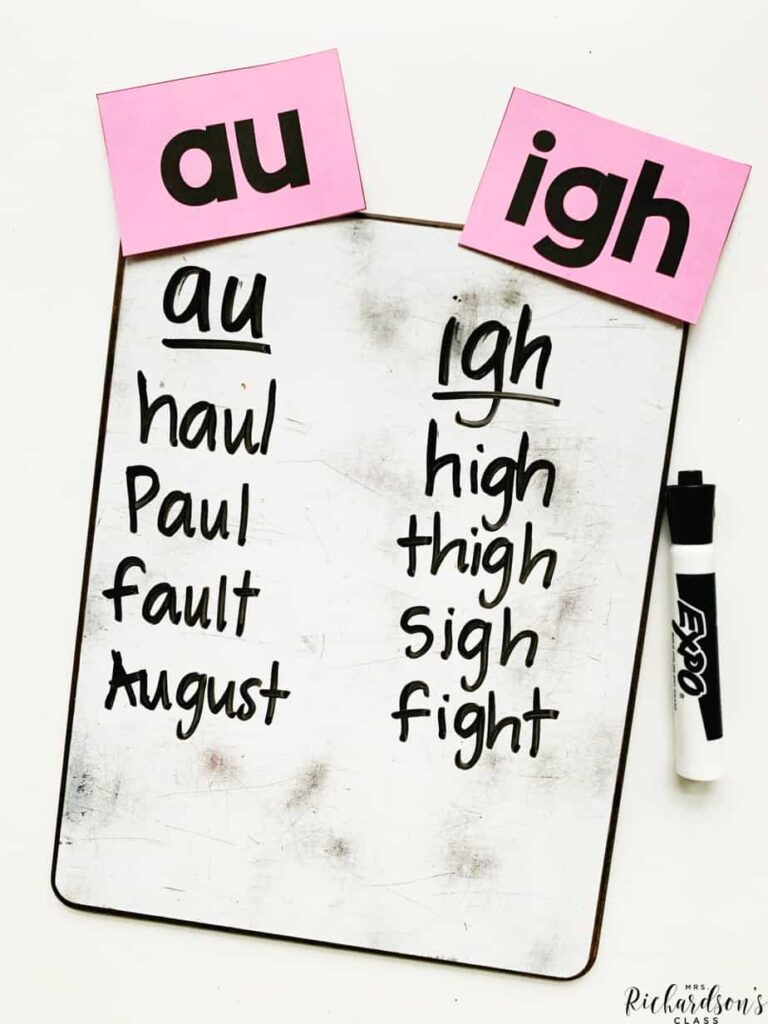
Mrs. Richardson’s Class/phonics practice example via mrsrichardsonsclass.com
Practice making words that have the same spelling pattern—for example, writing all the words that end in -igh. Choose spelling patterns students will see in the book you’re going to read so students can get maximum practice with the spelling patterns.
Read more: Phonics Activities
Preview the Text
Previewing the text, or looking at the main features, is a habit that you’ll want students to have as they read on their own. Use time during guided reading to preview each text before you read it.
Here’s how to preview a text with students:
During reading activities
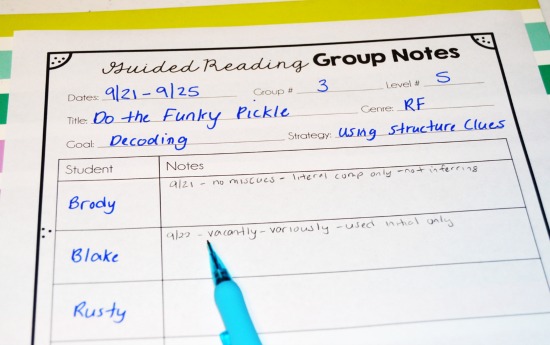
Teaching With Jennifer Findley/guided reading data tracker via jenniferfindley.com
During guided reading, the most important activity is reading. The teacher’s role is to listen as students read and then give them feedback on their reading. Correct a word here. Prompt them to use a strategy there.
Take notes on how students are reading each session so you have the data to track their progress.
Get it: Free printable guided reading note taker from Jennifer Findley
After reading activities
After students have read the text, it’s time to talk comprehension. They can practice retelling, answering questions, and discussing text with their small group. Their responses will show you how they’re doing in terms of understanding questions and pulling information out of the text.
Retelling Gloves
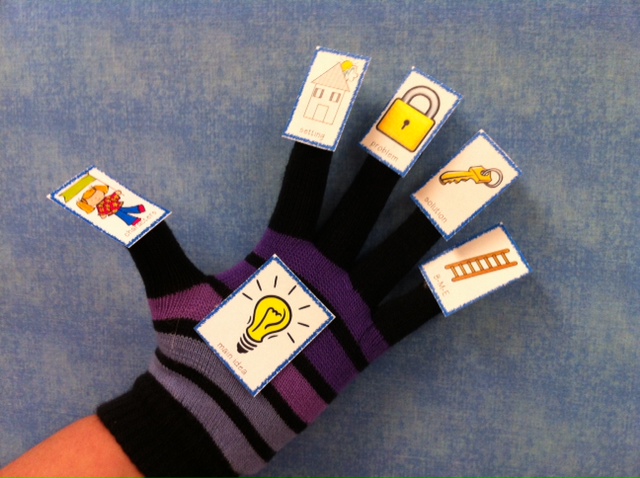
Buzzing With Ms. B/retelling gloves via buzzingwithmsb.com
Create a retelling glove and have students refer to each of the five fingers for each part of the story they should include in a retelling. This helps students who get lost in telling you all the details. You can have them put each finger down as they tell you that part of the story.
Learn more: Buzzing With Ms. B
Comprehension Fans
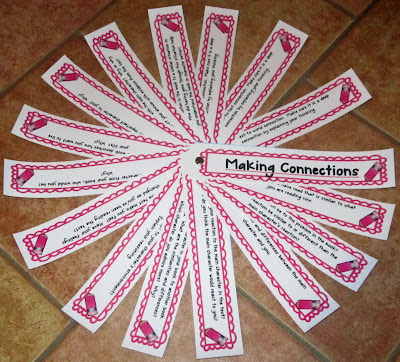
Runde’s Room/Comprehension Fans via rundesroom.com
Organize questions onto strips or cards, and put a collection of these questions on a ring to create a “fan” for this guided reading activity. Then have students select a question from the fan to ask a group, or write a response.
Learn more: Runde’s Room
Check out this list of printable questions for book discussions .
Fill In the Graphic Organizer
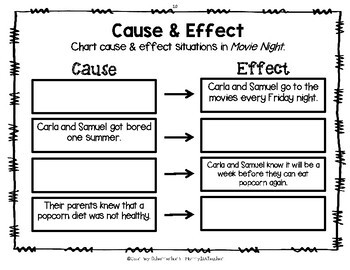
Courtney Schermerhorn/graphic organizer via teacherspayteachers.com
A graphic organizer is a great way to help students organize information they pull from a text. As students learn how to complete graphic organizers and use text structure to understand text, provide graphic organizers with some parts filled in to model a correct response (read: full sentences) and give students a scaffold to complete the entire organizer.
Buy it: Graphic organizer at Teachers Pay Teachers

Reading Dice
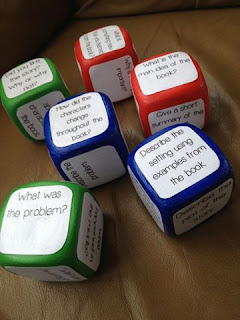
A Love 4 Teaching/reading dice via alove4teaching.blogspot.com
Write open-ended literature response questions on dice. Then, students roll the dice and answer the question that lands on top.
Learn more: A Love 4 Teaching
Comprehension Jenga
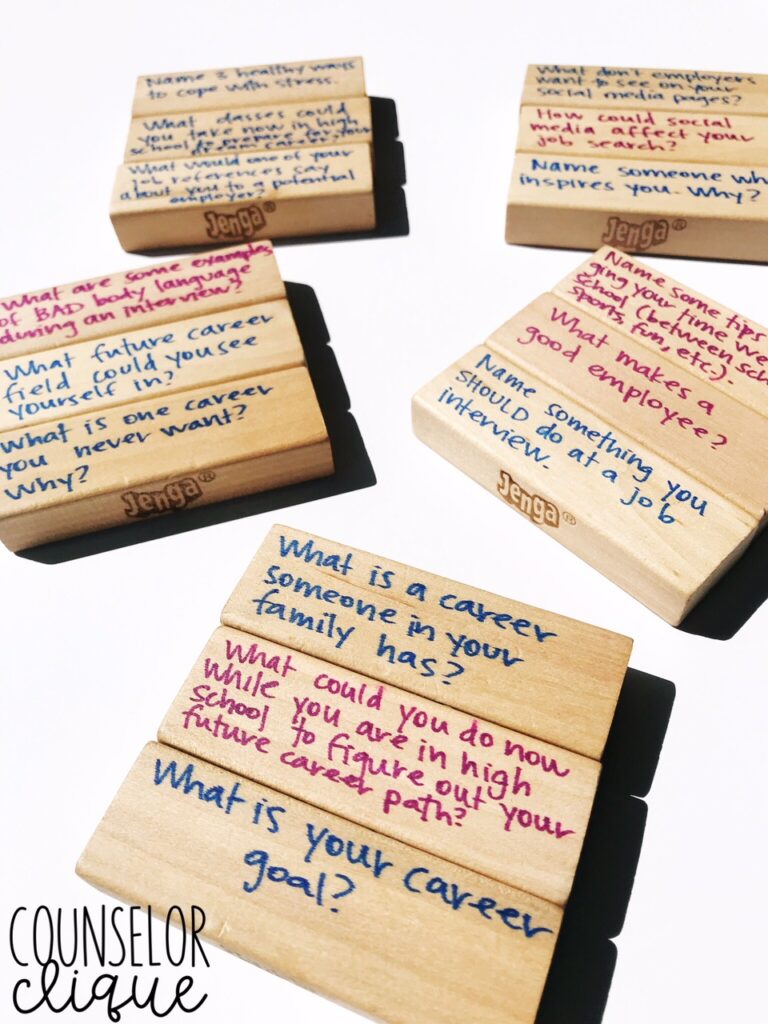
Counselor Clique/Questions on a Jenga game via counselorclique.com
Counselor Clique wrote questions for post-career goals in this example, but for guided reading, write questions on Jenga blocks that apply to your students’ age and reading goals. Then, play a game of Jenga—students pull a block from the stacked tower and answer the question they get.
Summarize Together
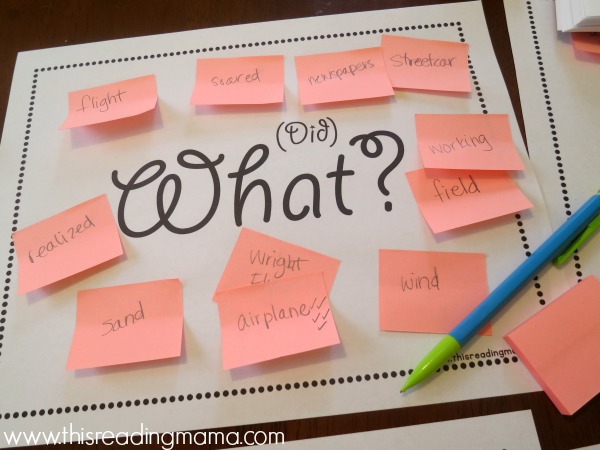
This Reading Mama/Summarizing Activity via thisreadingmama.com
Students practice summarizing using signal words by using sticky notes and papers that have the key features of a summary: who, what, when, where, why. After students write their signal words, they create a group summary by sticking them onto the paper. Over time, students can do this activity on their own or in a small group without direct supervision.
Read more: This Reading Mama
Bloom Balls
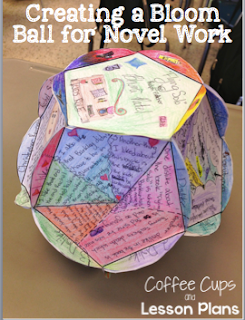
Coffee Cups & Lesson Plans/Bloom Ball activity via coffeecupslessonplans.com
Have older students create a Bloom Ball, a 12-sided ball with space to write on each side. Students write questions they can ask about any text, or projects they can do with any text, on each side. Then, they roll the ball to see which question they answer or which project they do.
Learn more at Coffee Cups & Lesson Plans .
Buy it: Bloom Ball template at Teachers Pay Teachers
Prediction Practice
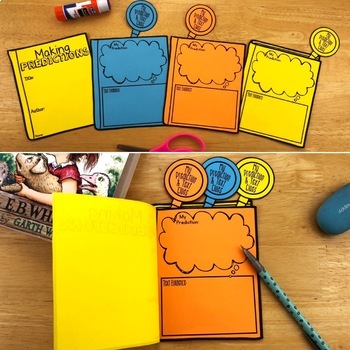
Raise the Bar Reading/making predictions activity via teacherspayteachers.com
Making predictions using information from the text is an important skill students use to maintain comprehension. Use a template, like this one from Raise the Bar Reading , to help students identify the information from the text, then use that information to make predictions.
Buy it: Making Predictions printable at Teachers Pay Teachers
Student-Led Groups
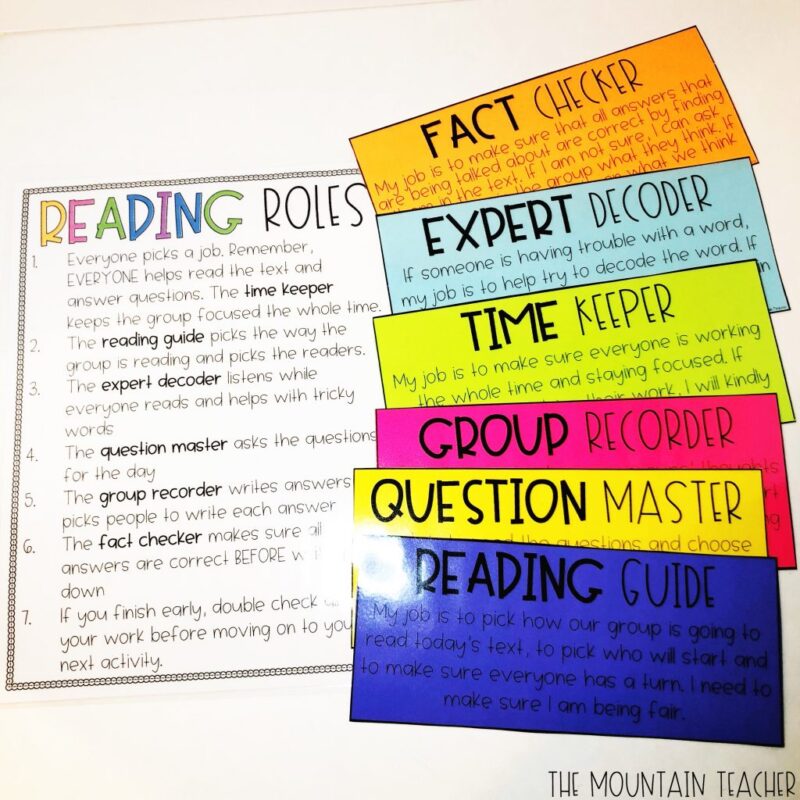
The Mountain Teacher/student-led reading groups via themountainteacher.com
As students get older and learn how to discuss text on their own, put them into groups to discuss. Having roles in the group can help some students stay on task, and ensures that everyone has something to be accountable for.
Learn more: The Mountain Teacher
Guided Writing
The last part of guided reading is writing! This is when students are able to consolidate everything they learned, put it into their own words, and maybe add some more ideas.
Letter Writing
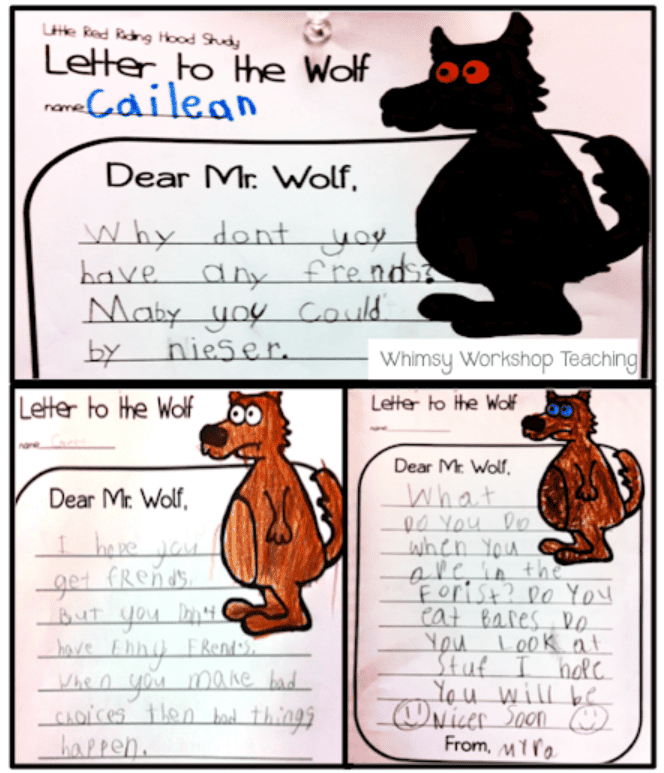
Whimsy Workshop Teaching/letter-writing examples via whimsyworkshopteaching.com
Letter writing is a great way to have students retell and engage with text. You can have students write a letter to a character (like the example from Whimsy Workshop Teaching ). Or have students put themselves in the mind of one character and write a letter to another character in the book from that point of view. This activity is good for after students read an especially dramatic part in the story and one character has a secret or new information they can’t wait to share.
Newspaper Article
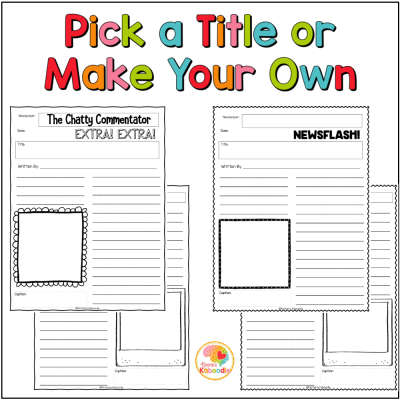
Kirsten’s Kaboodle/newspaper template via kirstenskaboodle.com
Newspaper writing is retelling for older students. This activity has students retell what happened in the day’s or week’s reading in a newspaper article format. Use a graphic organizer to make sure that students include all the relevant sections.
Buy it: Kirsten’s Kaboodle newspaper template
Pitch a Sequel
In this guided reading activity, have students write an idea for a sequel to the book or story they just read. Where would they take the characters next? What conflict would these characters get into next?
Comic Strip Retell
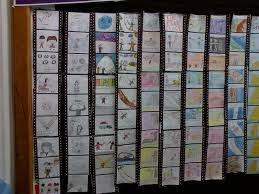
Mrs. RM/comic strip retelling via Pinterest
Another way to retell for older students: Use a comic strip format to show the beginning, middle, and end of a story or scene. For longer texts, you could have students build out a comic strip across multiple guided reading lessons, or have students work collaboratively to turn the entire story into a comic.
Graph Character Arc
This one will really engage students’ creativity. Students choose a type of graph (pie graph, chart, etc.) and track the character’s emotions or level of conflict in a scene or book. Label the graph with information from the story.
What are your favorite guided reading activity ideas? Share in our WeAreTeachers HELPLINE group on Facebook.
Check it out: 49 anchor charts all about reading comprehension ..
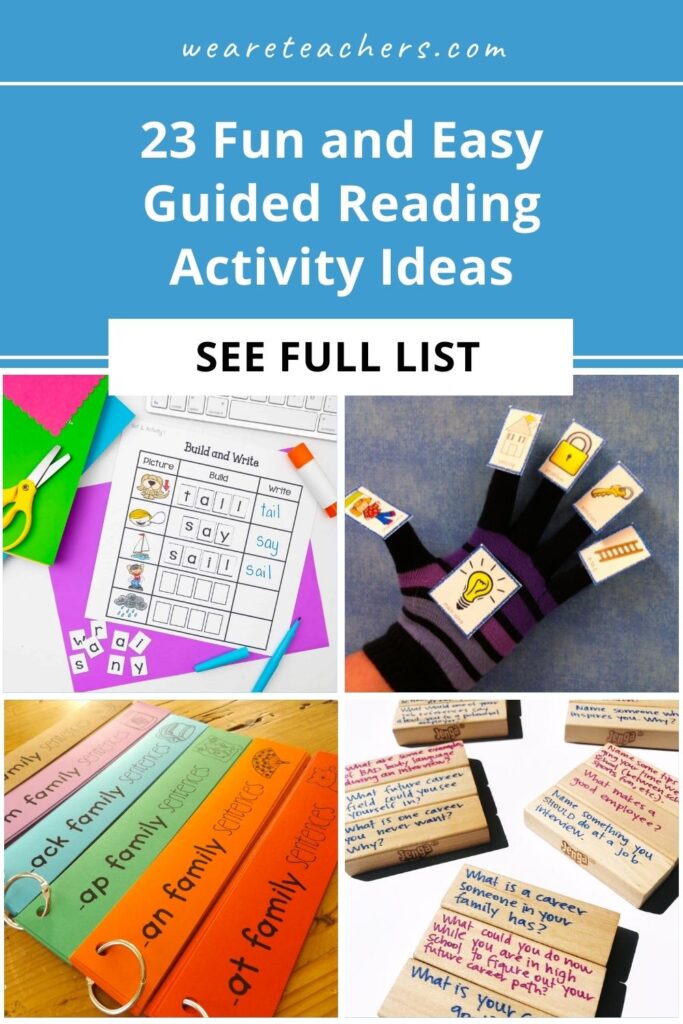
WeAreTeachers
You Might Also Like
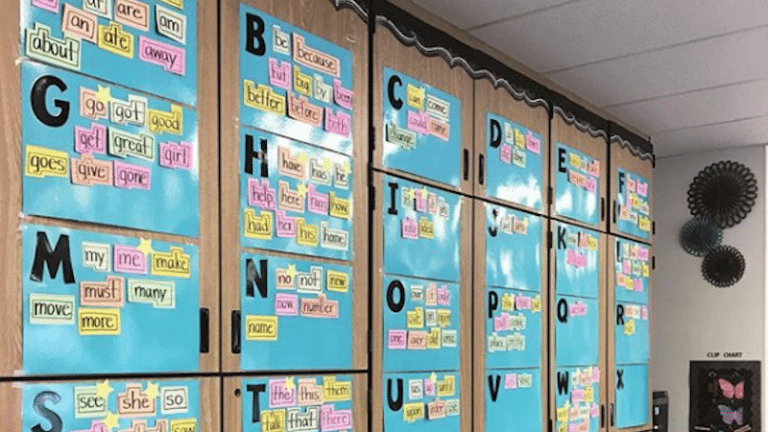
What Is a Word Wall?
A wall with words on it, right? Yes, and so much more. Continue Reading
Copyright © 2024. All rights reserved. 5335 Gate Parkway, Jacksonville, FL 32256
Search form

Here you can find activities to practise your reading skills. Reading will help you to improve your understanding of the language and build your vocabulary. The learning materials in this section are written and organised by level. There are different types of texts and interactive exercises that practise the reading skills you need to do well at school, get good marks in your tests and exams, and get more out of your free-time activities. Take our free online English test to find out which level to choose. Select your level, from beginner (CEFR level A1) to advanced (CEFR level C1), and improve your reading skills at any time and at your own speed.
Choose a level

Are you an elementary (CEFR level A1) learner of English? Practise and improve your reading skills with these texts and exercises.

Are you a pre-intermediate (CEFR level A2) learner of English? Practise and improve your reading skills with these texts and exercises.

Are you an intermediate (CEFR level B1) learner of English? Practise and improve your reading skills with these texts and exercises.

Are you an upper intermediate (CEFR level B2) learner of English? Practise and improve your reading skills with these texts and exercises.

Are you an advanced (CEFR level C1) learner of English? Practise and improve your reading skills with these texts and exercises.

Sign up to our newsletter for LearnEnglish Teens
We will process your data to send you our newsletter and updates based on your consent. You can unsubscribe at any time by clicking the "unsubscribe" link at the bottom of every email. Read our privacy policy for more information.

Here you can find activities to practise your reading skills. Reading will help you to improve your understanding of the language and build your vocabulary.
The self-study lessons in this section are written and organised by English level based on the Common European Framework of Reference for languages (CEFR). There are different types of texts and interactive exercises that practise the reading skills you need to do well in your studies, to get ahead at work and to communicate in English in your free time.
Take our free online English test to find out which level to choose. Select your level, from A1 English level (elementary) to C1 English level (advanced), and improve your reading skills at your own speed, whenever it's convenient for you.
Choose your level to practise your reading

Learn to read English with confidence
Our online English classes feature lots of useful learning materials and activities to help you develop your reading skills with confidence in a safe and inclusive learning environment.
Practise reading with your classmates in live group classes, get reading support from a personal tutor in one-to-one lessons or practise reading by yourself at your own speed with a self-study course.
Explore courses
Online courses

Group and one-to-one classes with expert teachers.

Learn English in your own time, at your own pace.

One-to-one sessions focused on a personal plan.

Get the score you need with private and group classes.
5.2 Effective Reading Strategies
Questions to Consider:
- What methods can you incorporate into your routine to allow adequate time for reading?
- What are the benefits and approaches to active reading?
- Do your courses or major have specific reading requirements?
Allowing Adequate Time for Reading
You should determine the reading requirements and expectations for every class very early in the semester. You also need to understand why you are reading the particular text you are assigned. Do you need to read closely for minute details that determine cause and effect? Or is your instructor asking you to skim several sources so you become more familiar with the topic? Knowing this reasoning will help you decide your timing, what notes to take, and how best to undertake the reading assignment.
Depending on the makeup of your schedule, you may end up reading both primary sources—such as legal documents, historic letters, or diaries—as well as textbooks, articles, and secondary sources, such as summaries or argumentative essays that use primary sources to stake a claim. You may also need to read current journalistic texts to stay current in local or global affairs. A realistic approach to scheduling your time to allow you to read and review all the reading you have for the semester will help you accomplish what can sometimes seem like an overwhelming task.
When you allow adequate time in your hectic schedule for reading, you are investing in your own success. Reading isn’t a magic pill, but it may seem like it when you consider all the benefits people reap from this ordinary practice. Famous successful people throughout history have been voracious readers. In fact, former U.S. president Harry Truman once said, “Not all readers are leaders, but all leaders are readers.” Writer of the U.S. Declaration of Independence, inventor, and also former U.S. president Thomas Jefferson claimed “I cannot live without books” at a time when keeping and reading books was an expensive pastime. Knowing what it meant to be kept from the joys of reading, 19th-century abolitionist Frederick Douglass said, “Once you learn to read, you will be forever free.” And finally, George R. R. Martin, the prolific author of the wildly successful Game of Thrones empire, declared, “A reader lives a thousand lives before he dies . . . The man who never reads lives only one.”
You can make time for reading in a number of ways that include determining your usual reading pace and speed, scheduling active reading sessions, and practicing recursive reading strategies.
Determining Reading Speed and Pacing
To determine your reading speed, select a section of text—passages in a textbook or pages in a novel. Time yourself reading that material for exactly 5 minutes, and note how much reading you accomplished in those 5 minutes. Multiply the amount of reading you accomplished in 5 minutes by 12 to determine your average reading pace (5 times 12 equals the 60 minutes of an hour). Of course, your reading pace will be different and take longer if you are taking notes while you read, but this calculation of reading pace gives you a good way to estimate your reading speed that you can adapt to other forms of reading.
So, for instance, if Marta was able to read 4 pages of a dense novel for her English class in 5 minutes, she should be able to read about 48 pages in one hour. Knowing this, Marta can accurately determine how much time she needs to devote to finishing the novel within a set amount of time, instead of just guessing. If the novel Marta is reading is 497 pages, then Marta would take the total page count (497) and divide that by her hourly reading rate (48 pages/hour) to determine that she needs about 10 to 11 hours overall. To finish the novel spread out over two weeks, Marta needs to read a little under an hour a day to accomplish this goal.
Calculating your reading rate in this manner does not take into account days where you’re too distracted and you have to reread passages or days when you just aren’t in the mood to read. And your reading rate will likely vary depending on how dense the content you’re reading is (e.g., a complex textbook vs. a comic book). Your pace may slow down somewhat if you are not very interested in what the text is about. What this method will help you do is be realistic about your reading time as opposed to waging a guess based on nothing and then becoming worried when you have far more reading to finish than the time available.
Chapter 3 , offers more detail on how best to determine your speed from one type of reading to the next so you are better able to schedule your reading.
Scheduling Set Times for Active Reading
Active reading takes longer than reading through passages without stopping. You may not need to read your latest sci-fi series actively while you’re lounging on the beach, but many other reading situations demand more attention from you. Active reading is particularly important for college courses. You are a scholar actively engaging with the text by posing questions, seeking answers, and clarifying any confusing elements. Plan to spend at least twice as long to read actively than to read passages without taking notes or otherwise marking select elements of the text.
To determine the time you need for active reading, use the same calculations you use to determine your traditional reading speed and double it. Remember that you need to determine your reading pace for all the classes you have in a particular semester and multiply your speed by the number of classes you have that require different types of reading.
Practicing Recursive Reading Strategies
One fact about reading for college courses that may become frustrating is that, in a way, it never ends. For all the reading you do, you end up doing even more rereading. It may be the same content, but you may be reading the passage more than once to detect the emphasis the writer places on one aspect of the topic or how frequently the writer dismisses a significant counterargument. This rereading is called recursive reading.
For most of what you read at the college level, you are trying to make sense of the text for a specific purpose—not just because the topic interests or entertains you. You need your full attention to decipher everything that’s going on in complex reading material—and you even need to be considering what the writer of the piece may not be including and why. This is why reading for comprehension is recursive.
Specifically, this boils down to seeing reading not as a formula but as a process that is far more circular than linear. You may read a selection from beginning to end, which is an excellent starting point, but for comprehension, you’ll need to go back and reread passages to determine meaning and make connections between the reading and the bigger learning environment that led you to the selection—that may be a single course or a program in your college, or it may be the larger discipline, such as all biologists or the community of scholars studying beach erosion.
People often say writing is rewriting. For college courses, reading is rereading.
Strong readers engage in numerous steps, sometimes combining more than one step simultaneously, but knowing the steps nonetheless. They include, not always in this order:
- bringing any prior knowledge about the topic to the reading session,
- asking yourself pertinent questions, both orally and in writing, about the content you are reading,
- inferring and/or implying information from what you read,
- learning unfamiliar discipline-specific terms,
- evaluating what you are reading, and eventually,
- applying what you’re reading to other learning and life situations you encounter.
Let’s break these steps into manageable chunks, because you are actually doing quite a lot when you read.
Accessing Prior Knowledge
When you read, you naturally think of anything else you may know about the topic, but when you read deliberately and actively, you make yourself more aware of accessing this prior knowledge. Have you ever watched a documentary about this topic? Did you study some aspect of it in another class? Do you have a hobby that is somehow connected to this material? All of this thinking will help you make sense of what you are reading.
Application
Imagining that you were given a chapter to read in your American history class about the Gettysburg Address, write down what you already know about this historic document. How might thinking through this prior knowledge help you better understand the text?
Asking Questions
Humans are naturally curious beings. As you read actively, you should be asking questions about the topic you are reading. Don’t just say the questions in your mind; write them down. You may ask: Why is this topic important? What is the relevance of this topic currently? Was this topic important a long time ago but irrelevant now? Why did my professor assign this reading?
You need a place where you can actually write down these questions; a separate page in your notes is a good place to begin. If you are taking notes on your computer, start a new document and write down the questions. Leave some room to answer the questions when you begin and again after you read.
Inferring and Implying
When you read, you can take the information on the page and infer , or conclude responses to related challenges from evidence or from your own reasoning. A student will likely be able to infer what material the professor will include on an exam by taking good notes throughout the classes leading up to the test.
Writers may imply information without directly stating a fact for a variety of reasons. Sometimes a writer may not want to come out explicitly and state a bias, but may imply or hint at his or her preference for one political party or another. You have to read carefully to find implications because they are indirect, but watching for them will help you comprehend the whole meaning of a passage.
Learning Vocabulary
Vocabulary specific to certain disciplines helps practitioners in that field engage and communicate with each other. Few people beyond undertakers and archeologists likely use the term sarcophagus in everyday communications, but for those disciplines, it is a meaningful distinction. Looking at the example, you can use context clues to figure out the meaning of the term sarcophagus because it is something undertakers and/or archeologists would recognize. At the very least, you can guess that it has something to do with death. As a potential professional in the field you’re studying, you need to know the lingo. You may already have a system in place to learn discipline-specific vocabulary, so use what you know works for you. Two strong strategies are to look up words in a dictionary (online or hard copy) to ensure you have the exact meaning for your discipline and to keep a dedicated list of words you see often in your reading. You can list the words with a short definition so you have a quick reference guide to help you learn the vocabulary.
Intelligent people always question and evaluate. This doesn’t mean they don’t trust others; they just need verification of facts to understand a topic well. It doesn’t make sense to learn incomplete or incorrect information about a subject just because you didn’t take the time to evaluate all the sources at your disposal. When early explorers were afraid to sail the world for fear of falling off the edge, they weren’t stupid; they just didn’t have all the necessary data to evaluate the situation.
When you evaluate a text, you are seeking to understand the presented topic. Depending on how long the text is, you will perform a number of steps and repeat many of these steps to evaluate all the elements the author presents. When you evaluate a text, you need to do the following:
- Scan the title and all headings.
- Read through the entire passage fully.
- Question what main point the author is making.
- Decide who the audience is.
- Identify what evidence/support the author uses.
- Consider if the author presents a balanced perspective on the main point.
- Recognize if the author introduced any biases in the text.
When you go through a text looking for each of these elements, you need to go beyond just answering the surface question; for instance, the audience may be a specific field of scientists, but could anyone else understand the text with some explanation? Why would that be important?
Analysis Question
Think of an article you need to read for a class. Take the steps above on how to evaluate a text, and apply the steps to the article. When you accomplish the task in each step, ask yourself and take notes to answer the question: Why is this important? For example, when you read the title, does that give you any additional information that will help you comprehend the text? If the text were written for a different audience, what might the author need to change to accommodate that group? How does an author’s bias distort an argument? This deep evaluation allows you to fully understand the main ideas and place the text in context with other material on the same subject, with current events, and within the discipline.
When you learn something new, it always connects to other knowledge you already have. One challenge we have is applying new information. It may be interesting to know the distance to the moon, but how do we apply it to something we need to do? If your biology instructor asked you to list several challenges of colonizing Mars and you do not know much about that planet’s exploration, you may be able to use your knowledge of how far Earth is from the moon to apply it to the new task. You may have to read several other texts in addition to reading graphs and charts to find this information.
That was the challenge the early space explorers faced along with myriad unknowns before space travel was a more regular occurrence. They had to take what they already knew and could study and read about and apply it to an unknown situation. These explorers wrote down their challenges, failures, and successes, and now scientists read those texts as a part of the ever-growing body of text about space travel. Application is a sophisticated level of thinking that helps turn theory into practice and challenges into successes.
Preparing to Read for Specific Disciplines in College
Different disciplines in college may have specific expectations, but you can depend on all subjects asking you to read to some degree. In this college reading requirement, you can succeed by learning to read actively, researching the topic and author, and recognizing how your own preconceived notions affect your reading. Reading for college isn’t the same as reading for pleasure or even just reading to learn something on your own because you are casually interested.
In college courses, your instructor may ask you to read articles, chapters, books, or primary sources (those original documents about which we write and study, such as letters between historic figures or the Declaration of Independence). Your instructor may want you to have a general background on a topic before you dive into that subject in class, so that you know the history of a topic, can start thinking about it, and can engage in a class discussion with more than a passing knowledge of the issue.
If you are about to participate in an in-depth six-week consideration of the U.S. Constitution but have never read it or anything written about it, you will have a hard time looking at anything in detail or understanding how and why it is significant. As you can imagine, a great deal has been written about the Constitution by scholars and citizens since the late 1700s when it was first put to paper (that’s how they did it then). While the actual document isn’t that long (about 12–15 pages depending on how it is presented), learning the details on how it came about, who was involved, and why it was and still is a significant document would take a considerable amount of time to read and digest. So, how do you do it all? Especially when you may have an instructor who drops hints that you may also love to read a historic novel covering the same time period . . . in your spare time , not required, of course! It can be daunting, especially if you are taking more than one course that has time-consuming reading lists. With a few strategic techniques, you can manage it all, but know that you must have a plan and schedule your required reading so you are also able to pick up that recommended historic novel—it may give you an entirely new perspective on the issue.
Strategies for Reading in College Disciplines
No universal law exists for how much reading instructors and institutions expect college students to undertake for various disciplines. Suffice it to say, it’s a LOT.
For most students, it is the volume of reading that catches them most off guard when they begin their college careers. A full course load might require 10–15 hours of reading per week, some of that covering content that will be more difficult than the reading for other courses.
You cannot possibly read word-for-word every single document you need to read for all your classes. That doesn’t mean you give up or decide to only read for your favorite classes or concoct a scheme to read 17 percent for each class and see how that works for you. You need to learn to skim, annotate, and take notes. All of these techniques will help you comprehend more of what you read, which is why we read in the first place. We’ll talk more later about annotating and note-taking, but for now consider what you know about skimming as opposed to active reading.
Skimming is not just glancing over the words on a page (or screen) to see if any of it sticks. Effective skimming allows you to take in the major points of a passage without the need for a time-consuming reading session that involves your active use of notations and annotations. Often you will need to engage in that painstaking level of active reading, but skimming is the first step—not an alternative to deep reading. The fact remains that neither do you need to read everything nor could you possibly accomplish that given your limited time. So learn this valuable skill of skimming as an accompaniment to your overall study tool kit, and with practice and experience, you will fully understand how valuable it is.
When you skim, look for guides to your understanding: headings, definitions, pull quotes, tables, and context clues. Textbooks are often helpful for skimming—they may already have made some of these skimming guides in bold or a different color, and chapters often follow a predictable outline. Some even provide an overview and summary for sections or chapters. Use whatever you can get, but don’t stop there. In textbooks that have some reading guides, or especially in text that does not, look for introductory words such as First or The purpose of this article . . . or summary words such as In conclusion . . . or Finally . These guides will help you read only those sentences or paragraphs that will give you the overall meaning or gist of a passage or book.
Now move to the meat of the passage. You want to take in the reading as a whole. For a book, look at the titles of each chapter if available. Read each chapter’s introductory paragraph and determine why the writer chose this particular order. Depending on what you’re reading, the chapters may be only informational, but often you’re looking for a specific argument. What position is the writer claiming? What support, counterarguments, and conclusions is the writer presenting?
Don’t think of skimming as a way to buzz through a boring reading assignment. It is a skill you should master so you can engage, at various levels, with all the reading you need to accomplish in college. End your skimming session with a few notes—terms to look up, questions you still have, and an overall summary. And recognize that you likely will return to that book or article for a more thorough reading if the material is useful.
Active Reading Strategies
Active reading differs significantly from skimming or reading for pleasure. You can think of active reading as a sort of conversation between you and the text (maybe between you and the author, but you don’t want to get the author’s personality too involved in this metaphor because that may skew your engagement with the text).
When you sit down to determine what your different classes expect you to read and you create a reading schedule to ensure you complete all the reading, think about when you should read the material strategically, not just how to get it all done . You should read textbook chapters and other reading assignments before you go into a lecture about that information. Don’t wait to see how the lecture goes before you read the material, or you may not understand the information in the lecture. Reading before class helps you put ideas together between your reading and the information you hear and discuss in class.
Different disciplines naturally have different types of texts, and you need to take this into account when you schedule your time for reading class material. For example, you may look at a poem for your world literature class and assume that it will not take you long to read because it is relatively short compared to the dense textbook you have for your economics class. But reading and understanding a poem can take a considerable amount of time when you realize you may need to stop numerous times to review the separate word meanings and how the words form images and connections throughout the poem.
The SQ3R Reading Strategy
You may have heard of the SQ3R method for active reading in your early education. This valuable technique is perfect for college reading. The title stands for S urvey, Q uestion, R ead, R ecite, R eview, and you can use the steps on virtually any assigned passage. Designed by Francis Pleasant Robinson in his 1961 book Effective Study, the active reading strategy gives readers a systematic way to work through any reading material.
Survey is similar to skimming. You look for clues to meaning by reading the titles, headings, introductions, summary, captions for graphics, and keywords. You can survey almost anything connected to the reading selection, including the copyright information, the date of the journal article, or the names and qualifications of the author(s). In this step, you decide what the general meaning is for the reading selection.
Question is your creation of questions to seek the main ideas, support, examples, and conclusions of the reading selection. Ask yourself these questions separately. Try to create valid questions about what you are about to read that have come into your mind as you engaged in the Survey step. Try turning the headings of the sections in the chapter into questions. Next, how does what you’re reading relate to you, your school, your community, and the world?
Read is when you actually read the passage. Try to find the answers to questions you developed in the previous step. Decide how much you are reading in chunks, either by paragraph for more complex readings or by section or even by an entire chapter. When you finish reading the selection, stop to make notes. Answer the questions by writing a note in the margin or other white space of the text.
You may also carefully underline or highlight text in addition to your notes. Use caution here that you don’t try to rush this step by haphazardly circling terms or the other extreme of underlining huge chunks of text. Don’t over-mark. You aren’t likely to remember what these cryptic marks mean later when you come back to use this active reading session to study. The text is the source of information—your marks and notes are just a way to organize and make sense of that information.
Recite means to speak out loud. By reciting, you are engaging other senses to remember the material—you read it (visual) and you said it (auditory). Stop reading momentarily in the step to answer your questions or clarify confusing sentences or paragraphs. You can recite a summary of what the text means to you. If you are not in a place where you can verbalize, such as a library or classroom, you can accomplish this step adequately by saying it in your head; however, to get the biggest bang for your buck, try to find a place where you can speak aloud. You may even want to try explaining the content to a friend.
Review is a recap. Go back over what you read and add more notes, ensuring you have captured the main points of the passage, identified the supporting evidence and examples, and understood the overall meaning. You may need to repeat some or all of the SQR3 steps during your review depending on the length and complexity of the material. Before you end your active reading session, write a short (no more than one page is optimal) summary of the text you read.
Reading Primary and Secondary Sources
Primary sources are original documents we study and from which we glean information; primary sources include letters, first editions of books, legal documents, and a variety of other texts. When scholars look at these documents to understand a period in history or a scientific challenge and then write about their findings, the scholar’s article is considered a secondary source. Readers have to keep several factors in mind when reading both primary and secondary sources.
Primary sources may contain dated material we now know is inaccurate. It may contain personal beliefs and biases the original writer didn’t intent to be openly published, and it may even present fanciful or creative ideas that do not support current knowledge. Readers can still gain great insight from primary sources, but readers need to understand the context from which the writer of the primary source wrote the text.
Likewise, secondary sources are inevitably another person’s perspective on the primary source, so a reader of secondary sources must also be aware of potential biases or preferences the secondary source writer inserts in the writing that may persuade an incautious reader to interpret the primary source in a particular manner.
For example, if you were to read a secondary source that is examining the U.S. Declaration of Independence (the primary source), you would have a much clearer idea of how the secondary source scholar presented the information from the primary source if you also read the Declaration for yourself instead of trusting the other writer’s interpretation. Most scholars are honest in writing secondary sources, but you as a reader of the source are trusting the writer to present a balanced perspective of the primary source. When possible, you should attempt to read a primary source in conjunction with the secondary source. The Internet helps immensely with this practice.
What Students Say
- How engaging the material is or how much I enjoy reading it.
- Whether or not the course is part of my major.
- Whether or not the instructor assesses knowledge from the reading (through quizzes, for example), or requires assignments based on the reading.
- Whether or not knowledge or information from the reading is required to participate in lecture.
- I read all of the assigned material.
- I read most of the assigned material.
- I skim the text and read the captions, examples, or summaries.
- I use a systematic method such as the Cornell method or something similar.
- I highlight or underline all the important information.
- I create outlines and/or note-cards.
- I use an app or program.
- I write notes in my text (print or digital).
- I don’t have a style. I just write down what seems important.
- I don't take many notes.
You can also take the anonymous What Students Say surveys to add your voice to this textbook. Your responses will be included in updates.
Students offered their views on these questions, and the results are displayed in the graphs below.
What is the most influential factor in how thoroughly you read the material for a given course?
What best describes your reading approach for required texts/materials for your classes?
What best describes your note-taking style?
Researching Topic and Author
During your preview stage, sometimes called pre-reading, you can easily pick up on information from various sources that may help you understand the material you’re reading more fully or place it in context with other important works in the discipline. If your selection is a book, flip it over or turn to the back pages and look for an author’s biography or note from the author. See if the book itself contains any other information about the author or the subject matter.
The main things you need to recall from your reading in college are the topics covered and how the information fits into the discipline. You can find these parts throughout the textbook chapter in the form of headings in larger and bold font, summary lists, and important quotations pulled out of the narrative. Use these features as you read to help you determine what the most important ideas are.
Remember, many books use quotations about the book or author as testimonials in a marketing approach to sell more books, so these may not be the most reliable sources of unbiased opinions, but it’s a start. Sometimes you can find a list of other books the author has written near the front of a book. Do you recognize any of the other titles? Can you do an Internet search for the name of the book or author? Go beyond the search results that want you to buy the book and see if you can glean any other relevant information about the author or the reading selection. Beyond a standard Internet search, try the library article database. These are more relevant to academic disciplines and contain resources you typically will not find in a standard search engine. If you are unfamiliar with how to use the library database, ask a reference librarian on campus. They are often underused resources that can point you in the right direction.
Understanding Your Own Preset Ideas on a Topic
Laura really enjoys learning about environmental issues. She has read many books and watched numerous televised documentaries on this topic and actively seeks out additional information on the environment. While Laura’s interest can help her understand a new reading encounter about the environment, Laura also has to be aware that with this interest, she also brings forward her preset ideas and biases about the topic. Sometimes these prejudices against other ideas relate to religion or nationality or even just tradition. Without evidence, thinking the way we always have is not a good enough reason; evidence can change, and at the very least it needs honest review and assessment to determine its validity. Ironically, we may not want to learn new ideas because that may mean we would have to give up old ideas we have already mastered, which can be a daunting prospect.
With every reading situation about the environment, Laura needs to remain open-minded about what she is about to read and pay careful attention if she begins to ignore certain parts of the text because of her preconceived notions. Learning new information can be very difficult if you balk at ideas that are different from what you’ve always thought. You may have to force yourself to listen to a different viewpoint multiple times to make sure you are not closing your mind to a viable solution your mindset does not currently allow.
Can you think of times you have struggled reading college content for a course? Which of these strategies might have helped you understand the content? Why do you think those strategies would work?
As an Amazon Associate we earn from qualifying purchases.
This book may not be used in the training of large language models or otherwise be ingested into large language models or generative AI offerings without OpenStax's permission.
Want to cite, share, or modify this book? This book uses the Creative Commons Attribution License and you must attribute OpenStax.
Access for free at https://openstax.org/books/college-success/pages/1-introduction
- Authors: Amy Baldwin
- Publisher/website: OpenStax
- Book title: College Success
- Publication date: Mar 27, 2020
- Location: Houston, Texas
- Book URL: https://openstax.org/books/college-success/pages/1-introduction
- Section URL: https://openstax.org/books/college-success/pages/5-2-effective-reading-strategies
© Sep 20, 2023 OpenStax. Textbook content produced by OpenStax is licensed under a Creative Commons Attribution License . The OpenStax name, OpenStax logo, OpenStax book covers, OpenStax CNX name, and OpenStax CNX logo are not subject to the Creative Commons license and may not be reproduced without the prior and express written consent of Rice University.
- Prodigy Math
- Prodigy English
- Is a Premium Membership Worth It?
- Promote a Growth Mindset
- Help Your Child Who's Struggling with Math
- Parent's Guide to Prodigy
- Assessments
- Math Curriculum Coverage
- English Curriculum Coverage
- Game Portal
27 Fun Reading Activities To Try At Home or In The Classroom
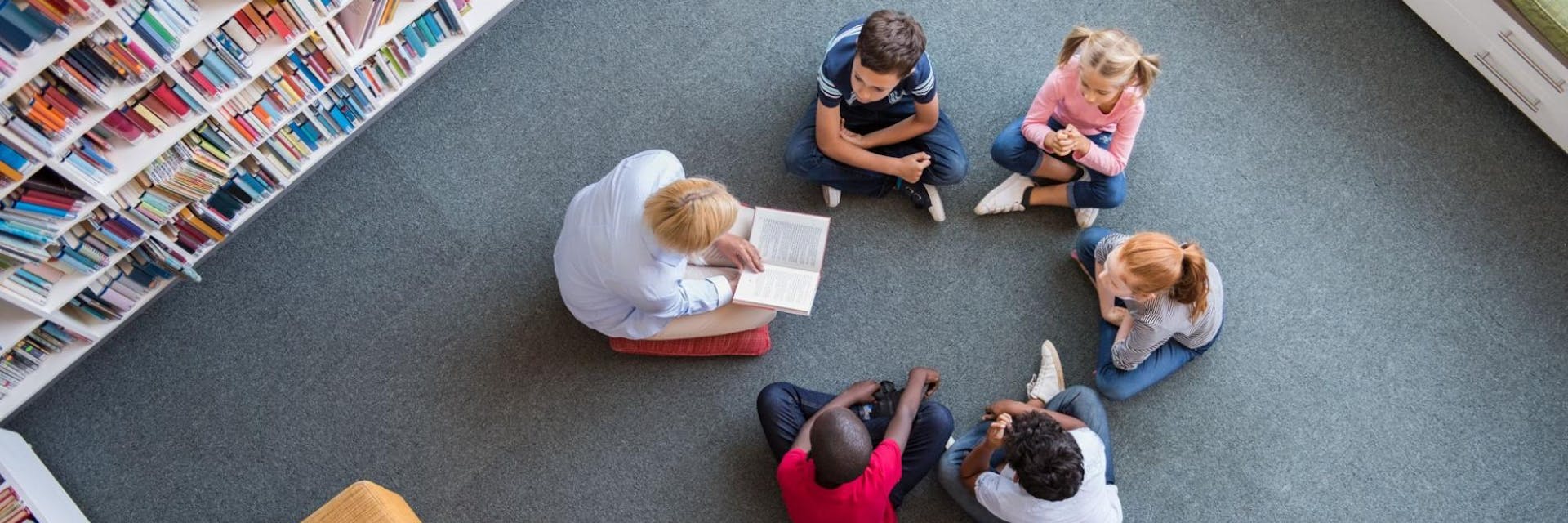
Written by Ashley Crowe
Teachers and parents
Prodigy English is ready to explore! Get kids playing — and learning — today.
Fun reading activities for the classroom
Reading activities for parents & children, activities to try after reading, other educational activities to help kids learn.
Learning to read is a huge milestone in a child’s life. We all know how important a love of reading is for future learning. When children love to read, they can learn anything.
Make sure your children keep the joy of reading alive by using fun reading activities along with traditional reading strategies .
These fun daily moments can improve reading skills and help reluctant readers find joy in the written word. We’ll be covering reading activities by grade level both for the classroom and at home, as well as some activities to improve reading comprehension after your students are reading independently.

Though many children begin the basics of reading at home, most solidify their skills and become accomplished readers in the classroom. These activities keep early readers engaged and improving while helping reluctant readers master the basics. Here are our favorite ways to keep reading fun!
1. Find the secret word
Great for: Kindergarten to 2nd grade
Turn a reading lesson into a scavenger hunt! Give each student or pair of students a piece of text, then speak the first secret word. Once they find it, have them circle it in a specific color, or circle and number, then report back to you for word #2.
Keep this word search up for as long as you like — we recommend choosing about 8 to 10 words for students to find. It’s one part competition, one part scavenger hunt! Choose a prize for each team to receive when they complete the activity. Or celebrate everyone reaching the end with a classroom dance party! It’s a great way to keep your kids moving and learning.
2. Read aloud as a class
Great for: All grades
Kids are never too old to hear a story read aloud. Reading aloud as a class is a great way to keep kids engrossed in a story. Since you are most familiar with the text, you can keep the flow going during the dramatic moments. Then hand it off to your students to take their turns.
Want to add a new element to your classroom read-aloud? Pass around a ball or stuffed animal to indicate the next reader. It’s a variation of popcorn reading to help minimize reading anxiety, and it gives kids the power to pass it on after spending a short time reading.
3. Partner reading
Great for: 1st to 3rd grade
Sometimes trying to get the whole class to read together is just too much. To encourage more reading time, pair up your students for partner reading.
During partner reading, each child will get more time to practice their skills. And being corrected privately by one friend may be better for a struggling reader’s confidence. Try to pair a confident but patient reader with those who need some extra help and watch them both learn to succeed.
4. Find the synonym
Great for: 2nd to 5th grade
Once your readers are feeling more confident, take our scavenger hunt game mentioned above and add a new twist.
Instead of searching for the exact spoken words on your list, give students the challenge to find the word’s synonym in the text. It’s a great way to keep the game challenging for older students.
5. Word searches
For younger students, a word search is a challenging way to encourage early reading. You can do this much like our scavenger hunt-style games, but instead of saying the words aloud, provide a list.
They can search for one word at a time, with you providing the next word to the team once the first is found. Or provide a full list from the beginning and let them work individually. Add in some color matching (marking the word in the same color as printed on the list) to keep this game fun and engaging.
6. Keyword bingo
Looking for a calmer alternative to the secret word game? Have each child work individually in a game of reading bingo. Choose a grade-level text and compile a list of words found in the passage.
Read each word aloud, giving about 15 seconds before moving on to the next. It’s a race against your clock to find the words, or they can try to remember them while looking for the others. When they find the words, they can mark them out. Once the list is done, allow 20 more seconds to wrap up any remaining words, then pencils down and count. Whoever finds the most words, wins!
7. Decoding games
Decoding games focus on letter sounds and phonemic awareness. A favorite game for pre-readers is to say a letter and have students find an object that starts with that letter. As they bring the object back, reinforce the sound that letter makes.
Other decoding games can focus on the mechanics of reading — such as reading a word or sentence from left to right. This is a great time to utilize finger puppets, following along with a finger as you sound the words out together.
8. Thumbs up, thumbs down
Great for: Kindergarten to 5th grade
Thumbs up, thumbs down (or the higher energy variation — stand up, sit down) is a great game to keep your students engaged.
Check reading comprehension when you ask students to give a thumbs up if a statement about a recently read story is true, or a thumbs down if it’s false. Help them grasp grammar concepts by having them stand up when you say an adjective word or sit down if you say a noun.
It’s a fun way to keep their bodies and brains working.
9. Discover the missing letter
When you’re teaching letter sounds, it’s fun to get creative. In this game, you’ll call your students to the front of the class by their names — minus the first letter. For example, Stacy becomes tacy and Roland becomes oland. Let the kids guess who you’re calling up, then have them decode the missing letter.
You can do the same thing for objects, or drop middle letters for older children. Just be sure to prepare your words ahead of time to avoid any slip-ups!
10. Guided reading ball game
Great for: 2nd to 7th grade
Grab a few beach balls from your local dollar store and get your classroom moving. Take a sharpie and write a discussion prompt on each colorful section of the ball. What is the setting? Who is the main character? What happened after…?
Toss or roll the balls around. Students answer whichever question their thumb lands on when the ball heads their way. This is an exciting way to mix things up, practice reading comprehension and get kids thinking outside of their seats.

Not all reading happens in the classroom! Parents can play an active role in helping their children learn to read. Here are a few activities to try with your kids.
1. Reading together
Great for: All grades and ages
There’s something special about listening to a book being read out loud. It can capture your attention in a unique way. Whether your child is a baby or fully grown, it’s always a good time to read together.
Take turns reading chapters from a favorite story, or just read to your child. Enjoying good stories is a huge motivator in learning to read.
2. Silly voices reading
Great for: Kindergarten to 4th grade
Kids love to laugh and joke, so play into this with a crazy story and silly voices. Get really high-pitched, speed it up like a chipmunk, and then pitch your voice low.
Your kids will love seeing these stories come to life with your words, and you’ll all share a good laugh. To get them involved in the fun, ask them to do their own silly voice!
3. Dialogic reading
The word dialogic means to have a dialogue, and that’s exactly what this activity is designed to do. Instead of reading to your child while they passively listen, invite them into the story. Ask them what they think may happen next, or at the close of the book invite them to create a completely different ending. This is a great way to stretch your little storyteller’s imagination.
4. Reading outside
Kids thrive outdoors. They can run, climb, and dig in the dirt. Outside is also a great place to practice reading and letter writing. Invite your child to help you create words in a sandbox or take a stick and dig a letter into the dirt.
Older kids can simply take their reading outside. It’s amazing how refreshing a change of setting can be.
5. What word starts with…
Great for: Kindergarten to 1st grade
Letter sounds are an essential early reading tool. With this game, ask your child to think of words that start with “B” (or any other letter).
Give an example, like b-b-butterfly, then think of more “B” words together. Choose your child’s favorite things to keep the game fun and exciting. Early readers especially love to talk about the letters in their names.
6. Try nonfiction
Great for: All ages
You never know what a child may love to read. Though many kids enjoy a good princess or dragon story, others will prefer non-fiction books.
If your attempts at fiction are met with indifference, try a book about their favorite animal (sharks, dinosaurs, or lemurs are popular here), learn about space or strange weather events. Whatever your child is into, and whatever their reading level, there’s a book for them.
7. Create a “book nook”
A cozy spot dedicated to reading can add joy to the activity. Load up a corner or top bunk space with comfy pillows and blankets, make sure it has good lighting, and include some sticky notes and a dictionary. All your child needs to bring is their favorite book! Even better, snuggle in together and discover a new favorite with your child.
8. Who’s coming over?
This game can be played in a couple of different ways, and both are great for reading comprehension. First, try giving clues so your child can guess their favorite characters. These favorites can be from books or TV. You can mention physical characteristics, some of their best friends, or things that happen to them. Keep giving clues until they guess correctly.
The second way to play is to invite a favorite character over and then discuss what you’ll need for their visit. A special kind of bed, their favorite foods, or a place for their pet to stay are all things to consider. This is a fun way to create your own story around your child’s favorite characters.
9. Take turns reading
As your child begins to read you can invite them to read to you. Don’t push if they don’t want to, but as their confidence builds they’ll be excited to share their new skill with you.
This may look like you both taking turns reading a new chapter book, or they may want to share all the creature descriptions from their favorite new computer game. No matter the topic, do your best to listen intently and congratulate them on their reading skills.
10. What happens next?
Keep reading fun and active when you step outside the book and asking your child what happens next:
- What do they think will happen?
- What would you like to see happen?
- What’s something funny that could happen?
Any question that gets them thinking through the story on their own is both fun and helpful for reading comprehension.
11. Talk about the pictures
Pictures are a great way for kids to follow along with a story. When your child is beginning to read, have them look at the pictures and ask what they think is going on. As they unravel the story, point out the words they are discovering in the text. Or just let them enjoy creating their own unique version of the story based on the pictures.
12. Try new reading apps and websites
There are some amazing reading apps for both reading instruction and digital reading libraries. If your child enjoys spending time on their tablet, give some of our favorite reading apps a try and watch them learn while they play.

After your child is reading on their own, there’s still plenty to learn. Reading isn’t effective if they’re struggling to understand the words on the page, or how they all fit together to create the story. Here are a few activities for children to practice reading comprehension.
1. Summarize the text
Once a child is done reading a text or section of a book, have them revisit the main ideas by highlighting or taking notes on the text’s biggest themes. Once students identify the main themes, ask them to break them down further and quickly summarize the story.
2. Book reports
Great for: 2nd to 12th grade
Book reports are a classic reading activity. Have the child analyze the book, highlighting the most important themes. Older children can present arguments pertaining to the story, and provide passages to support their theories.
Keep book reports even more engaging when you invite kids to give a presentation, complete with dress-up and drama.
3. Review the book
Ask children to rate their most recent reading. They can assign it a number of stars, but then they must also explain why. Was it too scary? Not funny? What were their favorite parts? What would they do differently?
Not only does this help students think critically about what they’ve just read, but it can also help parents and teacher identify what they might like reading next.
4. Extend the story
Great for: Kindergarten to 12th grade
“And they lived happily ever after…”
Maybe so, but what happened next? Ask your child to keep the story going. Where do they go next? Who do they meet? Favorite characters can continue adventuring when your child takes over the story. This is a great writing prompt , or just a fun dinner conversation!
5. How could it have been better?
Everyone has an opinion, so ask your child for theirs. How could this book or story have been better? Would a different ending be more fun? Or maybe they just think the main character should be named after them.
No matter their critique, listen and discuss. Then encourage them to create their own tale.
How reading activities help kids embrace learning
Reading keeps kids learning for the rest of their lives. When a child can read, they can take more control over their education. And that’s a wonderful thing!
Fun activities are the best way to keep a child interested in the world of books. Learning to read can be a frustrating journey for some. Others may simply find it boring (especially if they’re being made to read about topics they care little about). These activities are designed to get kids moving and thinking beyond the page. Because when reading is fun, learning happens naturally.

When teaching starts to feel like a drag, or the kids are fighting their instruction, revisit this article. Mix in some fun activities and keep the learning going. Getting up, moving around, or enjoying a laugh together can help stimulate everyone’s mind.
Looking for even more great learning activities to engage your kids? Here are some of our favorite activity posts for reading, math, and more!
- 21 Classroom Games
- 15 Geometry Activities
- 20 Exciting Math Games
- 30 Virtual School Activities
- 36 Fun Word Game for Kids
- 15 Free Multiplication Games
- 37 Quick Brain Breaks for Kids
- 27 Best Educational Games for Kids
- 25 Social-Emotional Learning Activities
Get more ways to help kids love learning with Prodigy English , a brand-new learning adventure! Whether you're a parent or a teacher, create a free Prodigy account to access tools that help you support reading and language learning in the classroom or at home.

Grammar exercises
Vocabulary exercises
Verbs exercises
Listening exercises
Reading - exercises
Videos - lessons
Songs - nursery-rhymes
Stories - fairy-tales
Phonetic - exercises
Worksheets - handouts
Reading exercises
comprehension exercises.
- Reading exercises - all levels
- Reading comprehension (exercises)
- Easy reading - (exercises)
- Reading levels: A1 -> C1
- Elementary and intermediate
- Elementary / intermediate tests
- Advanced reading activities
- Worksheets - pdf exercises
PRE-READING / PRESCHOOL
- Pre-reading - A1 / A2
- I am reading - 1st grade
TALES - STORIES - TALKS
- short stories - reading
- Tales - stories - reading
- Fairy tales (Grimms-Andersen)
- Fables: audio + transcript
- English talks transcripts
- Short stories (intermediate level)
Goals for student learning:
- Read carefully and with understanding
- Understand intellectual or disciplinary debates
- Gain a conceptual framework for in-class discussions or problem solving
Be aware that:
- Students, especially students new to your field, may complete a reading assignment quickly or shallowly.
- Students may divide up lengthy reading assignments with classmates or consult existing study guides rather than completing the reading on their own.
To encourage deep, honest, and active engagement:
- Provide students with guidance on and resources for how to read in your field; share your own reading and note-taking practices with them.
- Prioritize weekly reading assignments for students. What’s most crucial for them to complete?
- Situate a particular reading in its context or contexts (disciplinary, historical, etc.).
- Advise students on whether or how to use online synopses, syntheses, or reading guides that may be available to them.
Assignment types and examples:
- Weekly reading
- Close reading, listening, or “seeing”
- Case reading
- Observations/fieldwork
- Scientific reading
- Reading for context
- Reading for research
Resources for students:
Wayne C. Booth, Gregory G. Colomb, and Joseph M. Williams, The Craft of Research (Chicago: University of Chicago Press, 2008) BSC Resources on Reading Amanda Claybaugh, “How to Read a Novel” and “How to Read a Scholarly Monograph” Harvard Library: Research Guides on Reading Habits Michael Mitzenmacher, “How to Read a Research Paper”

How Graded Readers and Engaging Activities Can Ignite Student Interest in the Magic of Books
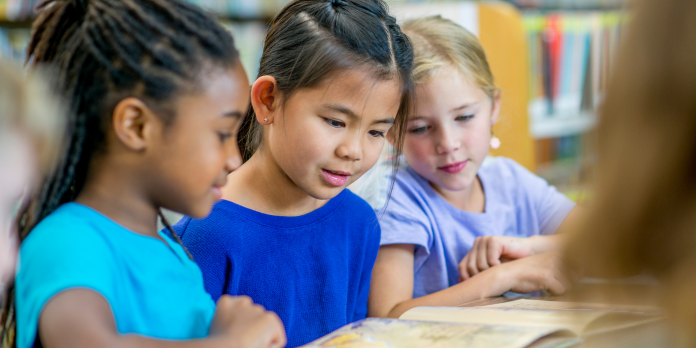
If contemporary societies view reading as an essential life skill, loving to read is definitely “the” gift that makes all the difference in a person’s life.
Reading for pleasure opens doors to all sorts of worlds for us to explore. When we are hooked on a story, we feel like we have jumped into the book’s pages to undergo an exciting reading experience. Times flies, our imagination goes riot, we are curious to know how the story unfolds, the words are full of powerful meaning and new words and expressions expand our linguistic repertoire. Likewise, when the story ends, we may even have a book hangover! Suddenly, we find it difficult to part in the company of those characters we’ve learned to love. Luckily, there is always another book around the corner, waiting for us to open it and read “Once Upon a Time…”, to make the magic happen all over again.
The powerful stories that circulate in our communities build bridges among generations, and readers develop a strong sense of belonging to their cultures and values. What is more, we remember information which comes in the form of a story because we connect with the narrative emotionally. Myths and legends are examples of how, in the past, we used to make sense of the world we lived in (Egan, 1998). Stories bring together schools and families. Just imagine parents and children reading together about the adventures of emblematic characters such as Sherlock Holmes, drawing the wall a selfish giant built around his castle, performing the gingerbread man’s traditional story or chanting Humpty Dumpty or Dr Seuss’ cat in the hat’s rhymes. As Brewster, Ellis and Girard (2002) say, stories and storytelling create the ideal learning context to undergo reading as a social experience.
Creative Reading as Classroom Practice
Let me introduce creative reading as classroom practice and show how it can be fun, engaging and memorable. We need three things: Developing reading routines, choosing appropriate graded readers and following a pre-, while- and post-reading model.
Reading Routines
Reading routines such as regular storytelling, reading aloud / reading alone time and book talk moments give learners the chance to express their personal response to the reading experience (Mourao & Ellis, 2021). In this way, we create communities of readers which make reading visible in the classroom with cosy reading corners and comfy cushions, shelves with books to read for pleasure and classroom walls decorated with the learners’ creative work which show reading in the making.
Graded Readers
Do not be scared to add a graded reader to your syllabus! These texts come from many different genres and teachers have a big palette to choose what topics to explore.
Graded readers are accessible to all. Their benefits are plenty. First, they are specifically produced for foreign language learners and use limited lexis and syntax according to the learners’ linguistic level. As students read to their reading ability, their motivation increases, and they develop a sense of achievement. For many students, this can be the first time they read a whole book in English! What a feeling of success, don’t you think?
Second, the graded readers’ appealing content triggers motivation. There are several abridged versions of all sorts of genres, such as folk and fairy tales, fables, traditional stories and modern classics with lively illustrations accompanying robust plots. [1] Choosing stories from around the world, for example, is a solid plan, since learners have access to world literature in their English class, learn and explore different cultures and human expression, gain global perspective and develop a broader worldview. Isn’t it fantastic? [2]
Following a Pre-, While- and Post-Reading Model
Planning a lesson on a graded reader is simpler than you think. By following a pre-, while- and post-reading model which organizes the lesson around three main stages, we will integrate graded readers into our syllabuses and exploit the full potential of the stories. We will exemplify activities which intend to inspire teachers to design creative tasks to accompany the reading experience since planning appealing activities for each stage is crucial to motivating learners to develop an interest in the story. [3]
First, as a pre-reading activity, we can bring realia into the classroom and show learners 5 different objects they can touch and play with. We tell them that only one of those objects appears in the story and ask them to look at the cover of the book to guess which one belongs to the story and give reasons for their choice. For the pre-reading phase, we can use the think-pair-share (TPS) collaborative learning strategy to foster interaction [4] . In this way, we are creating expectations about the story, we have made learning concrete with real objects, and we have given learners a specific task to carry out and reasons for listening/reading. Now the learners are motivated to listen to/read the story to confirm or discard their predictions.
Reading activities foster storytelling and interactive reading moments to trigger imagination, involve the learners in the narrative and play with sound, rhythm, and rhyme. This playful interaction with English sounds and rhythm has a very positive effect on memory building and language learning. The same happens with book talk moments which bring the learners’ own imagined or real worlds into the reading and create precious opportunities for spontaneous listening and speaking in the classroom in relaxed classroom practice. Storybooks and storytelling, as a social experience, create a rich environment for learning (Brewster, Ellis and Girard, 2002).
Last, post-reading activities nurture the learners’ connection with the story and respond creatively to the reading experience. Examples of these activities are: Draw your favourite scene, design an infographic with specific information about the story, use a graphic organizer to create a story mountain to represent its structure, perform the scenes you liked the most, create a collage to introduce a character, create a story cube to retell the story, design a different book cover or book jacket, create a poster to advertise the book, write a different ending, add a new character, do freeze frames to present the different scenes.
Sometimes, just introducing a slight minimal change to traditional reading activities is enough to trigger immediate interest. For example, completing a Venn diagram with specific information about two different elements is very often used for identifying, categorizing, comparing and contrasting information. When we add movement to the activity, learners have another stimulus. If we ask students to create the activity in pairs to pass it on to other learners to complete it, the challenge, engagement and enthusiasm grow since it becomes community-based. See the following example of an activity I created based on the primary course book series Buzz, book 6 (2023, p. 25)
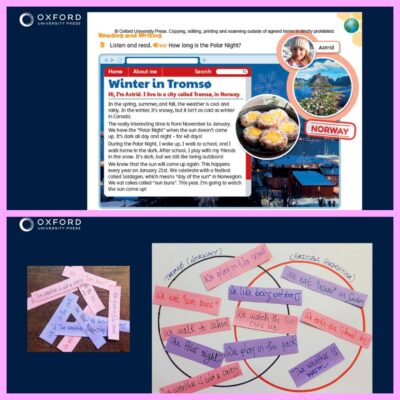
Beyond the Classroom Walls
Moreover, for those teachers who embrace creative reading and would like to go a step further, participating in international reading projects is a great option since these projects move beyond the classroom walls and bring together learners from faraway places. Oxford University Press, for example, carries out one such project every year: the Oxford Big Read competition [5] and provides online access to several resources, such as ready-to-use templates, genre information, rubrics to assess creative tasks and teaching tips to guide teachers to plan creative activities to work with graded readers.
Participating in global projects like Oxford Big Read offers schools the chance to show their commitment to teaching languages and gain international visibility and recognition. The whole school community participates in making these projects happen; families and teachers work together in collaborative contexts to support the learners’ efforts, involving parents in their children’s learning processes and schools in creating bonds with the learners’ homes. Most importantly, these kinds of creative reading experiences boost students’ love for reading, language learning, sharing with others and exercising agency.
Creative Reading in a Nutshell
To conclude, creative reading fosters a comprehensive language learning experience, which creates room for learners to explore and experiment with language from a very personal and creative perspective. It contributes to developing learners’ confidence in their reading process, in the learning of a foreign language, and the development of their creativity and criticality. [6]
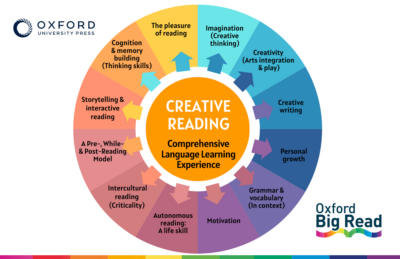
It is about loving to read and invites readers to let themselves go, be caught by the power of the narrative, develop empathy and engage their imagination in the reading process. It aims at educating learners, who have acquired tools to become critical, creative and independent readers, aware of their citizenship responsibilities, both at their local contexts and globally. All in all, be a daring teacher and give graded readers a chance!
_____________________________________________________________________________________________
Griselda Beacon is an English teacher with a Master’s degree in English Literature and Foreign Language Teaching from Philipps-Universität Marburg in Germany. She has extensive experience in teacher training and curriculum development for primary school. She is the co-author of the Together textbook series (Oxford UP, 2018) for teaching English in Argentina and co-editor of the book International Perspectives on Diversity in ELT (Palgrave, 2021). She is a teacher trainer for various educational institutions, including Oxford UP in South America and NILE – Norwich Institute for Language Education in England. Passionate about children’s literature, Griselda visits schools, reads picture books, tells stories, and carries out literary projects in primary school classrooms with literature and art that promote reading and creative writing, intercultural dialogue, and inclusion in English lessons. Based in the city of Buenos Aires, Argentina, Griselda works as a higher education teacher and teaches Children’s and Young Adult Literature, Creativity, and Theater Techniques in the English teacher training program.
Bibliographical references
Brewster, J., Ellis, G. & Girard, D. (2002). The Primary English Teacher’s Guide . Pearson ED
Douglas, S. R. (2017). Extensive reading for engaging learners beyond the textbook. Blog. Oxford University Press ELT. https://teachingenglishwithoxford.oup.com/2017/07/18/extensive-reading-the-key-to-language-learning-beyond-the-classroom/
Egan, K. (1998). The Educated Mind: How Cognitive Tools Shape Our Understanding. In Canadian Journal of Education / Revue canadienne de l education . Bibliovault OAI Repository, the University of Chicago Press. 68. 10.2307/1585992.
Mahony, M. & J. Ross (2023). Buzz , book 6. Oxford University Press.
Mourão, S., & Ellis, G. (2021). Demystifying the read-aloud. English Teaching Professional , (136), 22-25. Article 7. https://www.etprofessional.com/demystifying-the-read-aloud
https://www.oxfordbigread.com/
https:// www.oxfordreadingclub.com/
https://www.readingrockets.org/classroom/classroom-strategies/think-pair-share
https://www.teachingenglish.org.uk/professional-development/teachers/knowing subject/articles/making-reading-communicative
[1] See Oxford University Press selection of graded readers at https:// www.oxfordreadingclub.com/
[2] https://teachingenglishwithoxford.oup.com/2017/07/18/extensive-reading-the-key-to-language-learning- beyond-the-classroom/
[3] https://www.teachingenglish.org.uk/professional-development/teachers/knowing subject/articles/making-reading-communicative
[4] https://www.readingrockets.org/classroom/classroom-strategies/think-pair-share
[5] For more information about this global project, see https://www.oxfordbigread.com/
You may also like
Useful prompts for ai to help teachers save lesson planning time, four reasons you don’t need to feel worried about teaching english pronunciation., how to help your students deal with common grammar mistakes , leave a reply cancel reply, recent posts, helping advanced students overcome the language learning plateau, ‘play is for children’: myths about learning through play, the big debate: ai and inclusivity, four more reasons you don’t need to feel worried about teaching english pronunciation., recent comments.
Copyright 2023 © Oxford University Press 2023
Read our Privacy Policy , Cookie Policy & Legal Notice .
This blog contains external links. OUP are not responsible for the content of external sites nor do we endorse any companies or organisations linked to. Any views or opinions expressed in the articles on these posts are those of the author(s).
Oxford University Press - ELT
- International edition
- Australia edition
- Europe edition

Rageh Omaar says he was ‘determined to finish’ after becoming unwell on air
ITV’s international affairs editor became unwell while presenting News at Ten on Friday and is recovering at home
Rageh Omaar has thanked everyone for their “kindness and good wishes” as he recovers at home on Saturday after being treated in hospital.
The ITV News international affairs editor was presenting the News at Ten on Friday evening when he appeared shaky and to be having difficulty reading the news bulletins.
The incident sparked widespread concern from viewers on social media.
In a statement shared by ITV News, Omaar said: “I would like to thank everyone for their kindness and good wishes, especially all the medical staff, all my wonderful colleagues at ITV News, and our viewers who expressed concern. At the time, I was determined to finish presenting the programme. I am grateful for all the support I’ve been given.”
An ITV News spokesperson said: “We appreciate viewers of last night’s News at Ten were concerned about Rageh Omaar’s wellbeing.
“Following medical treatment at hospital, he is now recovering at home with his family. We are wishing Rageh a speedy recovery and look forward to him being back on screen when he feels ready.”
No further details were given about the journalist’s condition.
Omaar finished the broadcast, but a rerun of the programme was pulled from ITV’s +1 channel . A message was shown telling viewers that ITV was “temporarily unable to bring you our +1 service. We will resume shortly”.
Marverine Cole, a newsreader for ITV’s Good Morning Britain, wished Omaar “all the very best” in a message on X . The Channel 4 journalist Ayshah Tull also wished him “a speedy recovery” on the platform, adding that she was sending her “love to his family at what was a very worrying time for them”.
Omaar covers major global news stories as the international affairs editor, and presents ITV’s current affairs programme On Assignment. He joined ITV in 2013 as a special correspondent and presenter for ITV News, before being promoted to international affairs editor the following year.
The 56-year-old began his journalistic career in 1990 at the Voice newspaper in London, before moving to Ethiopia as a freelance foreign correspondent.
A former BBC senior foreign correspondent, Omaar became a household name during the 2003 invasion of Iraq while reporting from a hotel rooftop in Baghdad. He has written a book about the period, called Revolution Day, exploring the impact of Saddam Hussein’s regime and UN sanctions on Iraqi civilians.
- Rageh Omaar
- The Observer

Rageh Omaar: ‘Nothing prepares you for becoming a parent. I just sobbed’

ITV News crew forced to leave Bahrain ahead of grand prix

Rageh Omaar joins ITV News

Rageh Omaar: 'Idealism has become a dirty word among many journalists'
Most viewed.

Our expert, award-winning staff selects the products we cover and rigorously researches and tests our top picks. If you buy through our links, we may get a commission. Reviews ethics statement
- Services & Software
How to Watch and Stream the 2024 Miami GP
F1 is heading to Florida for the third Miami Grand Prix. Will Max Verstappen bring home gold for the third year in a row?

- Member of Screen Actors Guild and Actors Equity Association

Formula 1 has been racing in Miami for the past two years, and is heading back to the 305 for the 2024 Miami Grand Prix. While this course isn't a street circuit, it does have a very similar feel as it winds around Miami's Hard Rock Stadium and some faux marinas.
Max Verstappen and Red Bull have taken home first place at both previous Miami Grands Prix, so it's safe to assume that they will be looking to continue that winning streak this weekend.
After China, Red Bull will be looking to keep both their drivers at the top of the podium once again, after Verstappen and teammate Sergio Perez took home first and third respectively in Shanghai. Verstappen, unsurprisingly, has retained his No. 1 spot in the championship standings with 110 points. Perez trails him in second with 85 points, and Ferrari's Charles Leclerc retains third with 76 points.
This weekend's Grand Prix will follow the sprint race format, which means there will be extra events and racing that fans can tune into. The sprint action began on Friday with a Sprint Shootout and Practice session. On Saturday, drivers will race in the Sprint and qualify for the Sunday Grand Prix.
The main race, which takes place on Sunday May 5 at 3:55 p.m ET (12:55 p.m PT) will be held at the Miami International Autodrome. The race will air on ABC and ESPN Plus.
The entire race weekend, including practice sessions and qualifying, will be shown in the US on ESPN's family of TV and streaming networks. Folks looking to follow all of it will need access to the ABC and ESPN news channels on cable or live TV streaming services, or the ESPN Plus streaming service. We've broken down everything you need to know to stream today's race, and all the other F1 races this season.

Fans can catch teams' special liveries (the design of the car) this weekend to celebrate the Miami Grand Prix.
When, where and what time are the races?
Races are held on Sunday and are usually spaced two weeks apart. Here's the entire schedule.
F1 2024 schedule
Best option for streaming in the us , carries f1 races in the us.
Whether or not you have cable, ESPN's stand-alone streaming service is great for casual fans of Formula 1 and is a must-have accessory for fanatics. It costs $11 a month (or $110 a year) and currently, ESPN has a deal with F1 to show 18 out of 23 Grands Prix this year. The catch is that ESPN Plus doesn't always air the free practice or qualifying sessions, but it tends to air Sprint races and the Sprint Shootout.
If you're an F1 fan who's also looking to get your Disney fix, the Disney trio bundle (Hulu, Disney Plus and ESPN Plus) might end up being an even better buy. It's great for fans who love catching the parts of the race weekend that typically air on EPSN2 or ESPNews, and who need the latest Marvel movies or Star Wars shows.
If you're a diehard fan of motorsports and Formula series racing, ESPN Plus might not be for you, given that it rarely covers F2, F3 or Porsche Supercar racing. That's why ESPN Plus is ideal for casual fans who enjoy catching a race every once in a while, or super fans who don't want or need all of the extra bells and whistles of F1 TV, but want to beef up their coverage options.
Read our full review of ESPN Plus .
How to watch F1 online from anywhere using a VPN
If you find yourself unable to view the race locally, you may need a different way to watch -- that's where using a VPN can come in handy. A VPN is also the best way to stop your ISP from throttling your speeds on race day by encrypting your traffic, and it's also a great idea if you're traveling and find yourself connected to a Wi-Fi network, and you want to add an extra layer of privacy for your devices and logins.
With a VPN, you're able to virtually change your location on your phone, tablet or laptop to get access to the game. Most VPNs, like our Editors' Choice, ExpressVPN , make it really easy to do this.
Using a VPN to watch or stream sports is legal in any country where VPNs are legal, including the US, UK and Canada, as long as you have a legitimate subscription to the service you're streaming. You should be sure your VPN is set up correctly to prevent leaks: Even where VPNs are legal, the streaming service may terminate the account of anyone it deems to be circumventing correctly applied blackout restrictions.
Looking for other options? Be sure to check out some of the other great VPN deals taking place right now.

Best VPN for streaming
ExpressVPN is our current best VPN pick for people who want a reliable and safe VPN, and it works on a variety of devices. It's normally $13 a month, and you can sign up for ExpressVPN and save 35% -- the equivalent of $8.32 a month -- if you get an annual subscription.
Note that ExpressVPN offers a 30-day money-back guarantee.
Livestream F1 racing in the UK
F1 in the UK is shown on Sky Sports and Channel 4 -- Sky Sports airs the races, practice rounds and qualifying, while free-to-air Channel 4 offers highlights broadcast after the day's action takes place. If you already have Sky Sports as part of your TV package, you can stream the race via its app, but cord-cutters can watch Sky TV with unlimited Sky Sports on a Now TV membership.

Sky Sports and Now TV
F1 streaming in the uk.
Those in the UK will need Sky Sports to watch F1 racing in 2024. If you subscribe to Sky, you can get the £22 Complete Sports package in order to get the races.
Cord-cutters can also opt for the £35-a-month package on Now TV and get unlimited Sky Sports.
Other options for streaming in the US without cable
Beyond ESPN Plus, numerous live TV streaming services carry channels with F1. Race weekends normally start on Friday with multiple practice runs and continue on Saturday with qualifying. The races themselves take place Sunday. ESPN typically airs practices and qualifying on a mix of ESPN 2 and ESPNews, while the races tend to air on ESPN. F1 events in North America often land on ABC.
Here are some of the best ways to catch the entire race weekend without cable.
Carries ABC, ESPN, ESPN 2, ESPNews
You can catch the entire race weekend with a subscription to YouTube TV, which costs $73 per month. ABC, ESPN, ESPN 2 and ESPNews are all included in the package, which means you'll have all the channels you need in order to watch every second of the action.
Read our YouTube TV review .
Hulu Plus Live TV
Carries abc, espn, espn2, espnews.
Hulu Plus Live TV costs more than YouTube TV at $77 per month, and offers all the channels you need to watch every second of race weekend. As an added bonus, Hulu Plus Live TV comes with the rest of the Disney Bundle, which includes a Hulu on-demand content, along with subscriptions to Disney Plus and ESPN Plus.
Read our Hulu Plus Live TV review .
Sling TV Orange
Carries espn, espn2 and some abc stations.
Sling TV's $40 Orange plan (currently on sale for $20) might be a good choice for F1 fans who are primarily looking to just watch the races on Sundays. This plan is one of the cheapest ways to get access to ESPN and ESPN 2. Those looking for ESPNews will have to opt for the $11 Sports Extra add-on. Sling TV offers ABC as well but only in select cities.
Read our Sling TV review .
Carries ABC, ESPN, ESPN2
Fubo costs $80 per month and includes ABC, ESPN and ESPN 2. The base package lacks ESPNews, but you can add it for an extra $8 a month with the Fubo Extra package, or pay for the $90-a-month Elite streaming tier that includes Fubo Extra. Check out which local networks Fubo offers here .
Read our Fubo review .
DirecTV Stream
Carries abc, espn, espn 2.
DirecTV Stream is one of the most expensive live TV streaming services. Its cheapest, $80-a-month Plus package includes ESPN, ESPN 2 and ABC, but you'll need to move up to the $109-a-month Choice plan to get ESPNews. You can use its channel lookup tool to see which local channels are available in your area.
Read our DirecTV Stream review .
Livestreams all F1, F2, F3 and Porsche Supercup races
For gearheads looking to get every angle on the action, F1 offers its own streaming service. F1 TV Pro costs $85 per season, or $11 per month, and gives fans access to all races from F1, F2, F3 and Porsche Supercup. You'll be able to livestream every track session from all F1 Grands Prix and have access to all driver onboard cameras and team radios. You'll also be able to watch full on-demand races, replays and highlights, along with F1's historic race archive.
F1 also offers a TV Access Plan for $30 per year, or $3.50 per month, which only gives you on-demand access to races once they have been completed. You will still be able to view all F1 onboard cameras, along with full replays of F1, F2, F3 and Porsche Supercup. It also includes the historic race archive.
Services and Software Guides
- Best iPhone VPN
- Best Free VPN
- Best Android VPN
- Best Mac VPN
- Best Mobile VPN
- Best VPN for Firestick
- Best VPN for Windows
- Fastest VPN
- Best Cheap VPN
- Best Password Manager
- Best Antivirus
- Best Identity Theft Protection
- Best LastPass Alternative
- Best Live TV Streaming Service
- Best Streaming Service
- Best Free TV Streaming Service
- Best Music Streaming Services
- Best Web Hosting
- Best Minecraft Server Hosting
- Best Website Builder
- Best Dating Sites
- Best Language Learning Apps
- Best Weather App
- Best Stargazing Apps
- Best Cloud Storage
- Best Resume Writing Services
- New Coverage on Operating Systems
- Hostinger Coupon Codes
- HR&R Block Coupons
- ShutterStock Coupon Codes
- FedEx Office Coupons
- Coursera Coupons
- Autodesk Coupons
- Codeacademy Coupon Codes
- iolo Techologies Coupons
- Norton Coupon Codes

IMAGES
VIDEO
COMMENTS
Find free reading worksheets for various skills and genres, aligned to Common Core State Standards. You can save, edit, print, or complete online the worksheets for fiction and nonfiction passages, author's purpose, characterization, inferences, irony, and more.
Find over 100 free children's stories and worksheets to improve reading comprehension skills. Choose from different topics and grade levels, or become a member for more content and benefits.
Find high-quality reading worksheets, activities, and resources aligned with Common Core State Standards. Browse by skill, grade level, or topic, or try online reading tests and games.
Under 600 words. "Getting a New Job" - Advanced Level. 8 questions. Under 600 words. "The Dinner Party" - Advanced Level. 9 questions. Under 600 words. High quality reading comprehension worksheets for all ages and ability levels. Teachers in the classroom and at home are sure to find our materials very useful.
2. Read Aloud. Amazon. This tried and true activity never gets old, and it's one of the most valuable activities we can do with kids. With so many wonderful picks for the preschool audience, you'll make your students laugh and help them learn valuable lessons about the world and their lives. 3.
Reading Comprehension Worksheets Grades 1 - 10. Use our free, printable reading comprehension passage exercises to improve your student's reading skills! Recognizing letters and words is an important first step in learning to read. However, it is only a first step; it is vital that students comprehend, or understand, what they are reading.
Reading comprehension exercises — online, free, & adaptive. Fits K-12, ESL and adult students. Easily track progress for the entire class. ... Bonus points - set Recurring Activities once, and you're good for the year! Easy-to-use reporting. Track individual student and class progress in real-time. Identify where additional practice is ...
CommonLit offers thousands of reading lessons, ELA curriculum, assessments, and data for teachers, students, and families. Compare plans and prices for schools and districts to access CommonLit features and support.
Find hundreds of reading worksheets by skill level, topic, and format. Students can practice reading comprehension, main idea, letter formation, and more with interactive or printable worksheets.
Syntax: sentences and clauses. Syntax: conventions of standard English. Usage and style. ELA practice exercises (beta) for 2nd to 9th grade, covering reading comprehension and vocabulary. Aligned to Common Core State Standards for Reading: Literature; Reading: Informational Text, and Vocabulary Acquisition and Use.
Grade 3 stories and exercises. Use these free, printable worksheets to practice and improve reading comprehension, vocabulary and writing. Included are fiction and non-fiction passages at a grade 3 level. All worksheets are pdf files. 3rd grade reading comprehension worksheet.
Compatible with all devices and digital platforms, including GOOGLE CLASSROOM. Fun, Engaging, Open-Ended INDEPENDENT tasks. 20+ 5-Star Ratings ⭐⭐⭐⭐⭐. $3.00 Download on TpT. Open ended Reading activities: Awesome reading tasks and reading hands on activities for any book or age group. Fiction and Non-Fiction.
Grade 2 reading comprehension. Use these free, printable worksheets to practice and improve reading comprehension, vocabulary and writing. Each worksheet includes a short fiction or non-fiction passage followed by some questions. These worksheets are at a 2nd grade level. 1st grade reading comprehension worksheet.
ReadWorks is an edtech nonprofit organization that is committed to helping to solve America's reading comprehension crisis. ReadWorks is an edtech nonprofit organization that is committed to helping to solve America's reading comprehension crisis. ... Once deleted, you and your students will no longer be able to access the class, its ...
A guided reading schedule may also include intervention or Tier 2 groups. Read more about reading intervention. Mini-Lesson Activities. Each guided reading lesson will start with a mini-lesson. You don't have a lot of time, so focus on one aspect of reading that students are going to apply in the book that day. Build and Write Words
There are different types of texts and interactive exercises that practise the reading skills you need to do well at school, get good marks in your tests and exams, and get more out of your free-time activities. Take our free online English test to find out which level to choose. Select your level, from beginner (CEFR level A1) to advanced ...
Discover your current English level by taking our free online test. Here you can find activities to practise your reading skills. Reading will help you to improve your understanding of the language and build your vocabulary. The self-study lessons in this section are written and organised by English level based on the Common European Framework ...
Our mission is to improve educational access and learning for everyone. OpenStax is part of Rice University, which is a 501 (c) (3) nonprofit. Give today and help us reach more students. Help. OpenStax. This free textbook is an OpenStax resource written to increase student access to high-quality, peer-reviewed learning materials.
After your child is reading on their own, there's still plenty to learn. Reading isn't effective if they're struggling to understand the words on the page, or how they all fit together to create the story. Here are a few activities for children to practice reading comprehension. 1. Summarize the text. Great for: All ages
These activities have been developed by national reading experts for you to use with children, ages birth to Grade 6. The activities are meant to be used in addition to reading with children every day. In using these activities, your main goal will be to develop great enthusiasm in the reader for reading and writing. You are the child's ...
Reading comprehension exercises for all levels esl. Free interactive reading exercises. Fables, short stories, English talks, ebooks. English second language, English foreign language, ESL , EFL, ielts ... Advanced reading activities; Worksheets - pdf exercises; PRE-READING / PRESCHOOL . Pre-reading - A1 / A2; I am reading - 1st grade; TALES ...
Situate a particular reading in its context or contexts (disciplinary, historical, etc.). Advise students on whether or how to use online synopses, syntheses, or reading guides that may be available to them. Assignment types and examples: Resources for students: [email protected].
Reading activities foster storytelling and interactive reading moments to trigger imagination, involve the learners in the narrative and play with sound, rhythm, and rhyme. This playful interaction with English sounds and rhythm has a very positive effect on memory building and language learning. The same happens with book talk moments which ...
As we progress towards the exam, we need to help students integrate these skills and provide activities to help them engage with texts in multiple ways. In this blog we provide four activities to help students improve their vocabulary, as well as their understanding of context and the relationship between meaning and form. Exploring beyond the test
A Secret Service agent assigned to Vice President Kamala Harris' detail was removed from their assignment after displaying behavior that colleagues found "distressing," the agency said.
ITV's international affairs editor became unwell while presenting News at Ten on Friday and is recovering at home Rageh Omaar has thanked everyone for their "kindness and good wishes" as he ...
Kevin Lynch is a London-born, Dublin-based writer and journalist. The author of Steve Jobs: A Biographic Portrait, Kevin is a regular feature writer for a number of tech sites and the former ...